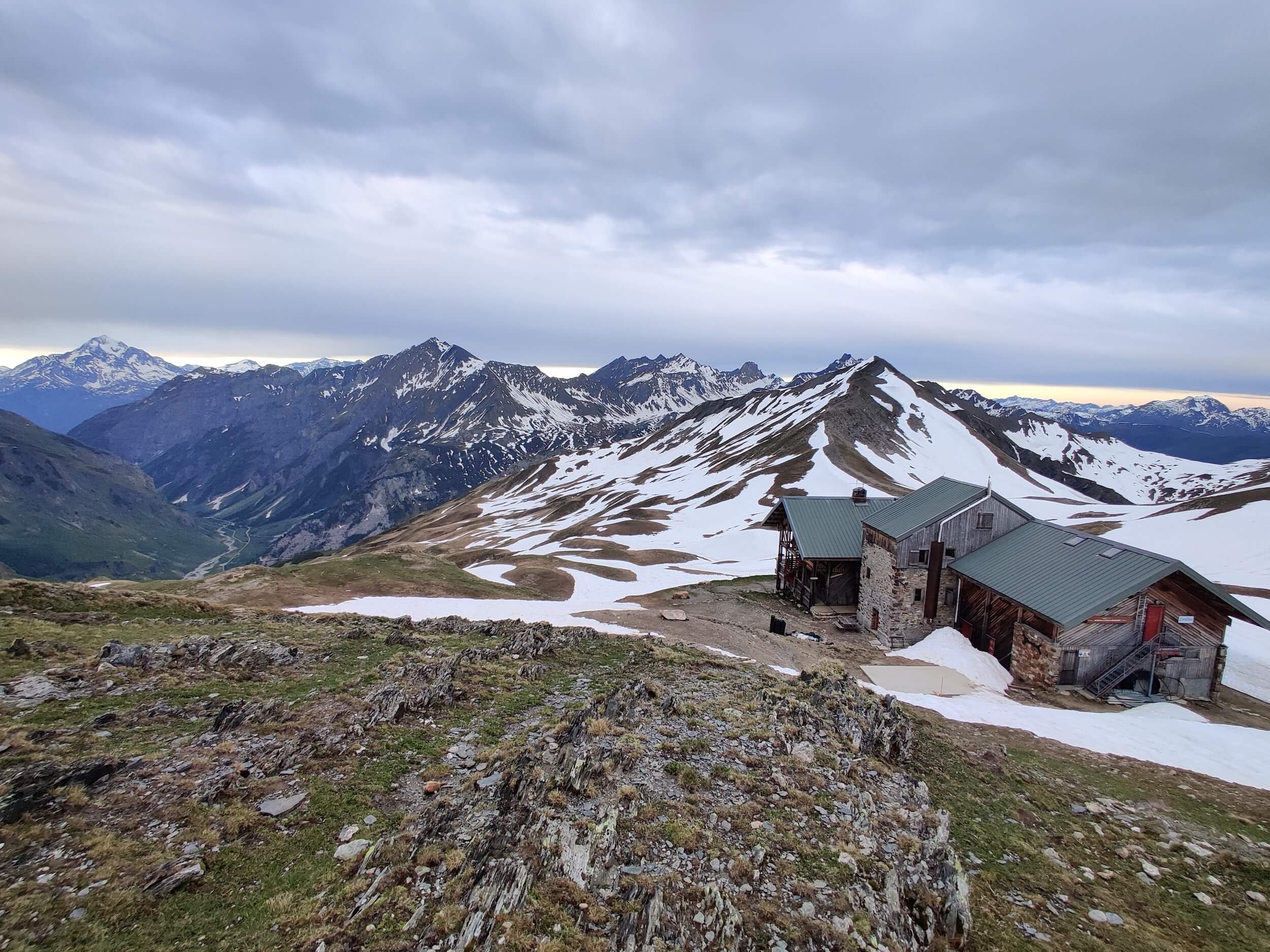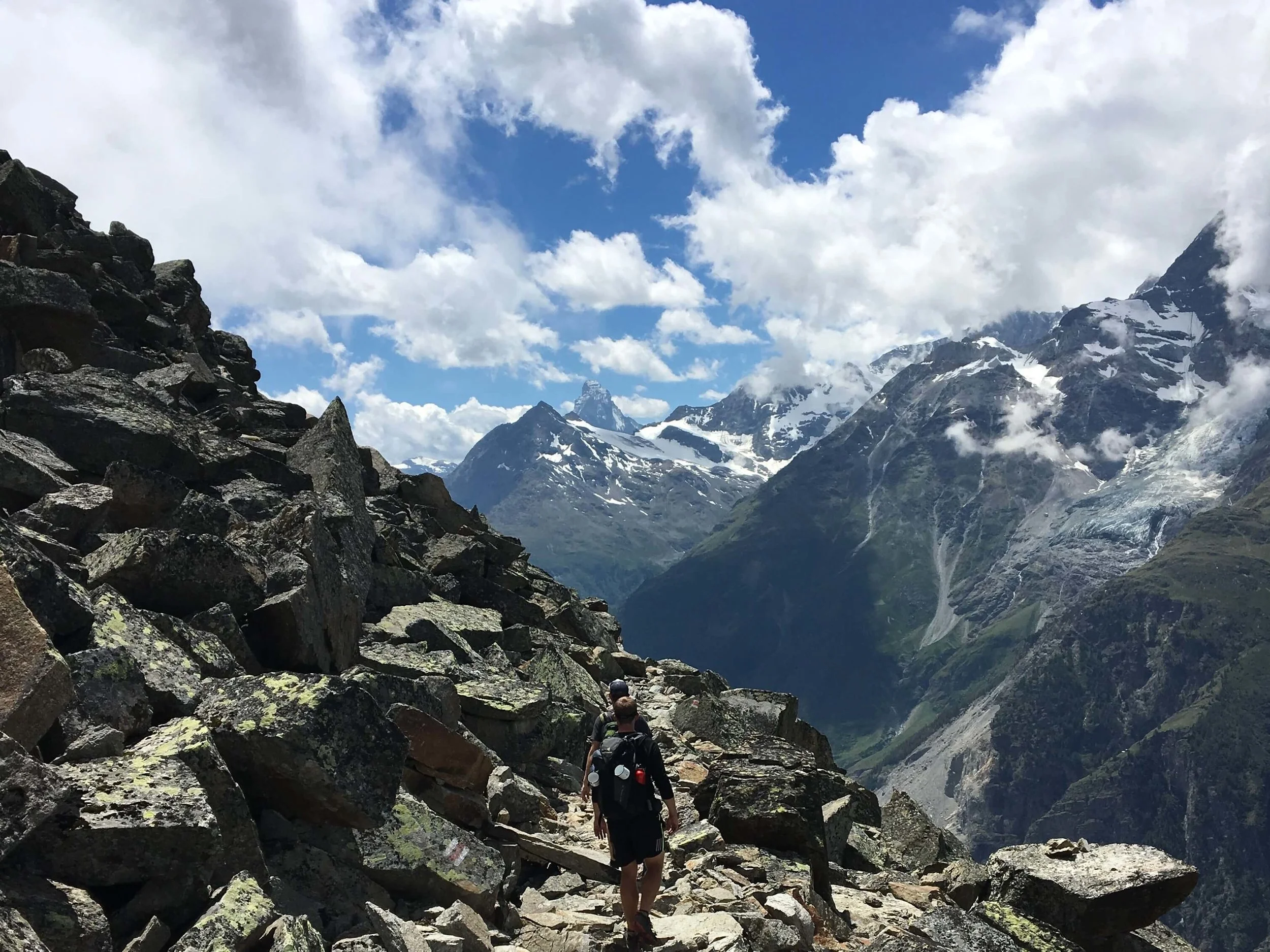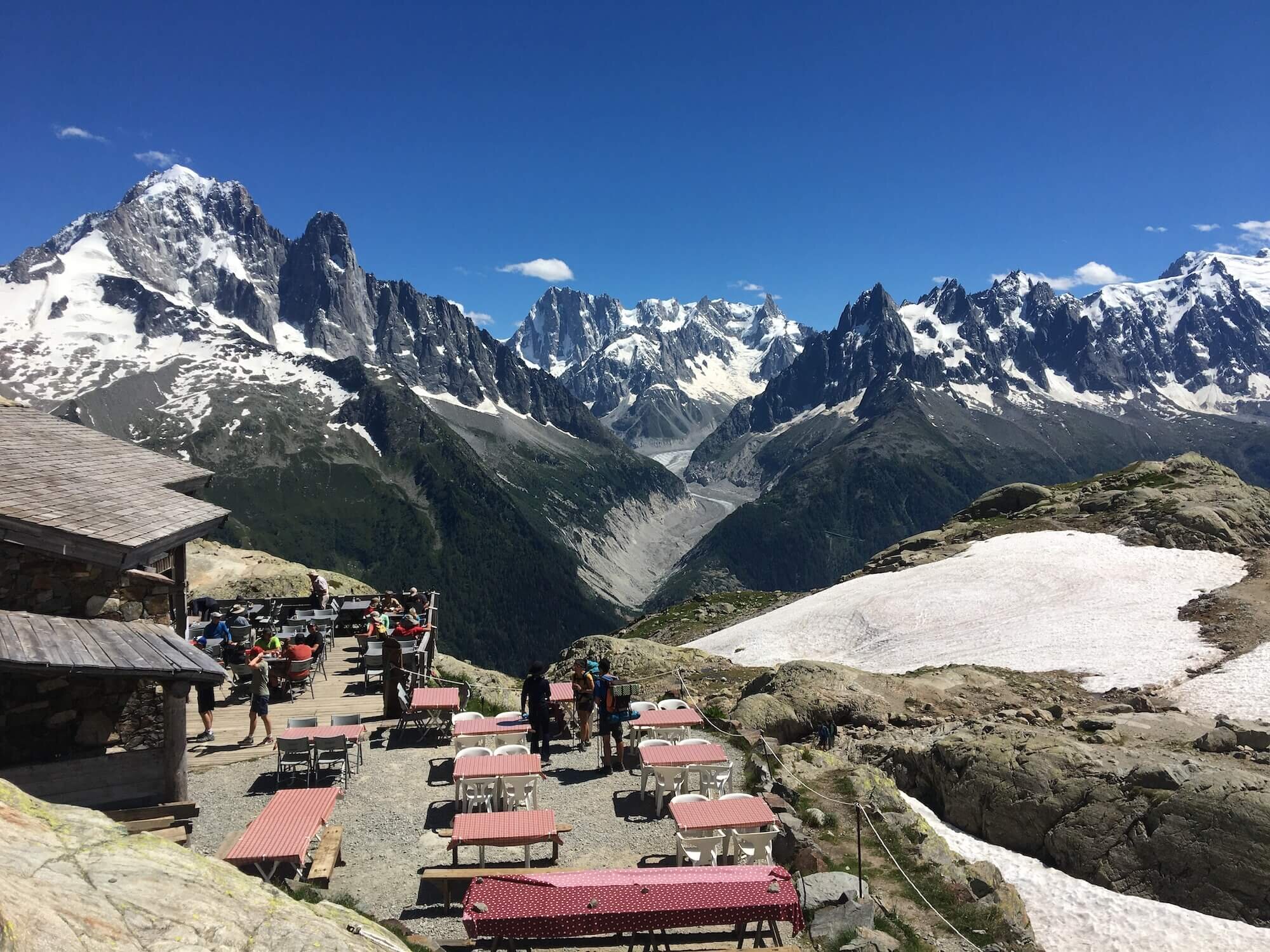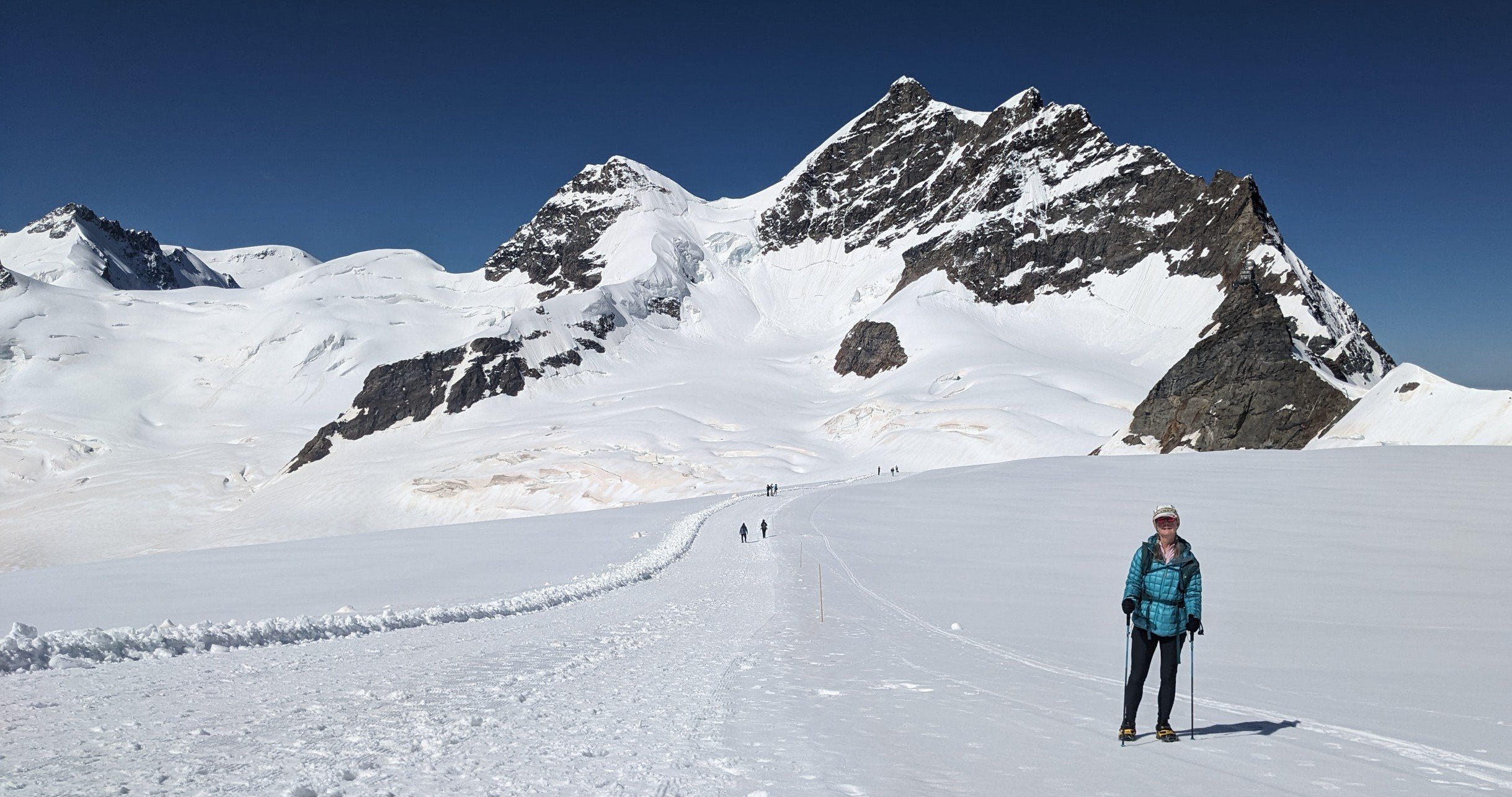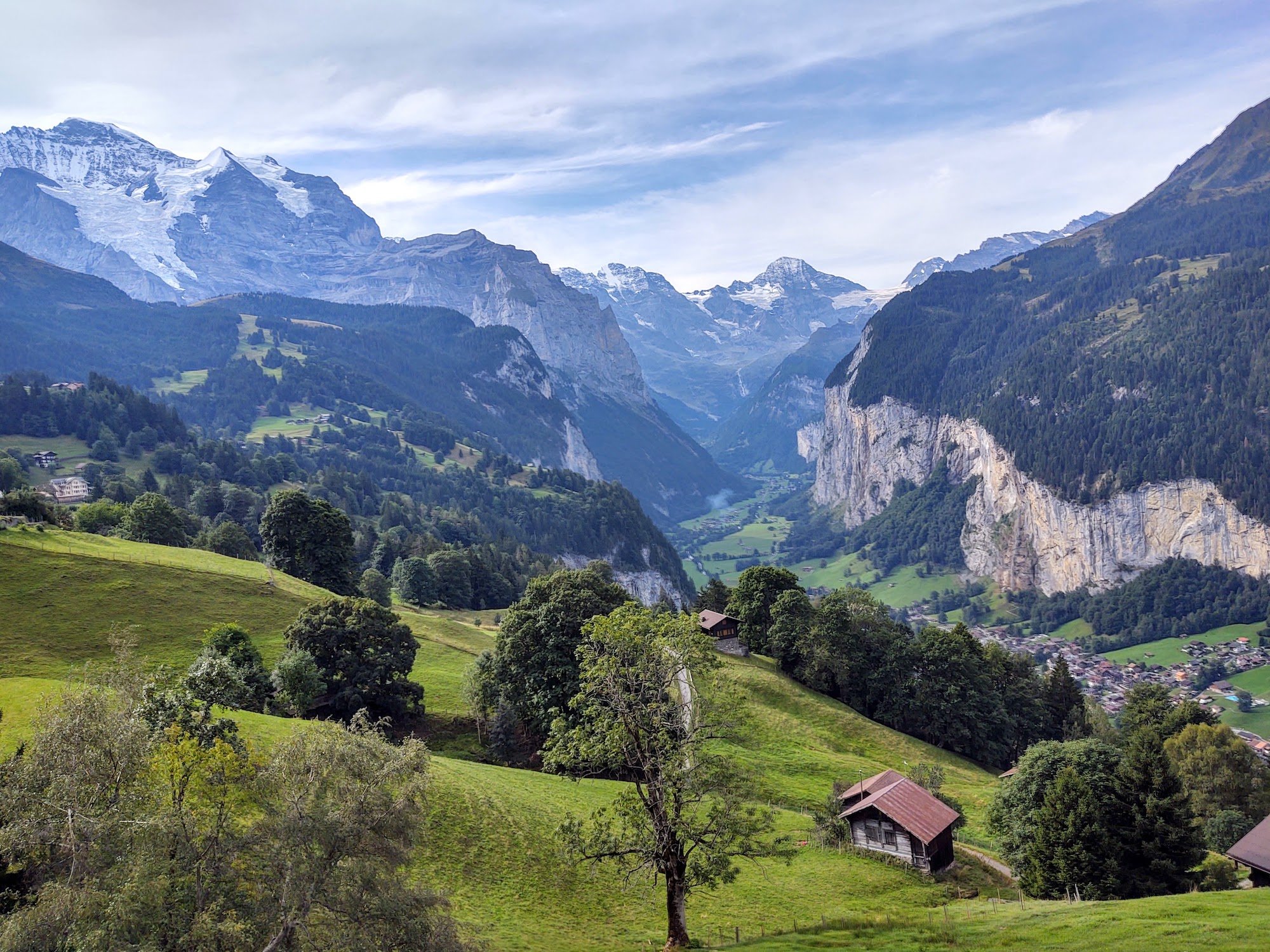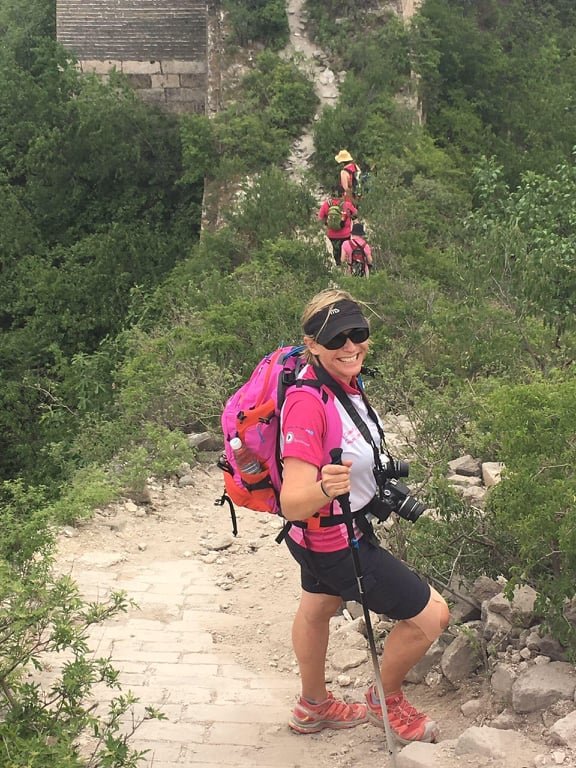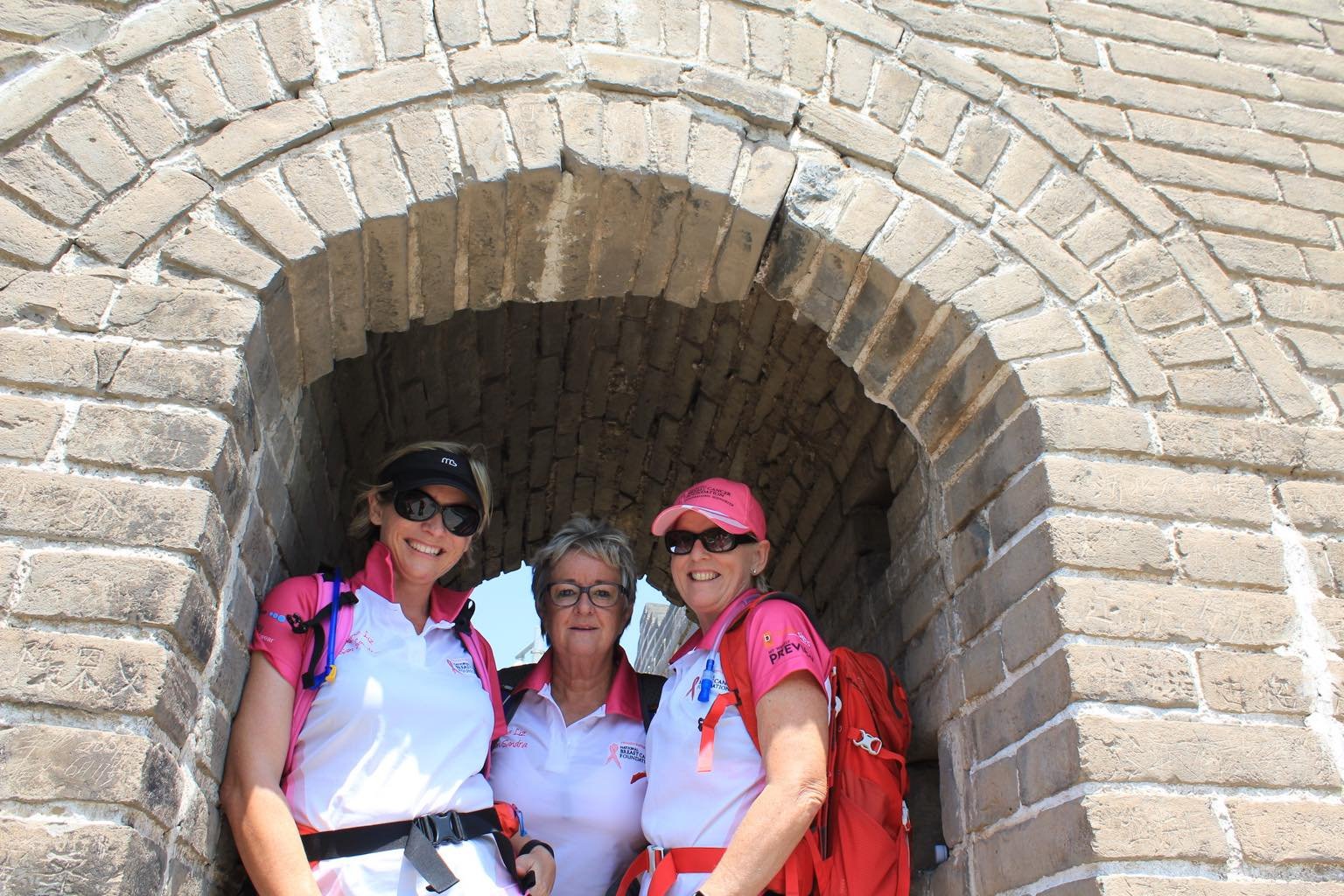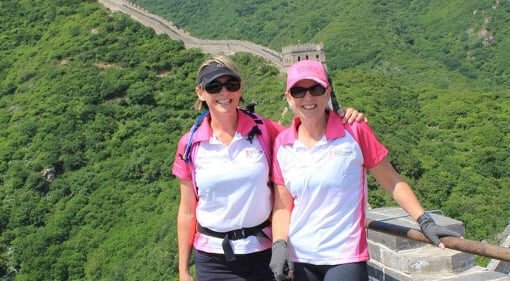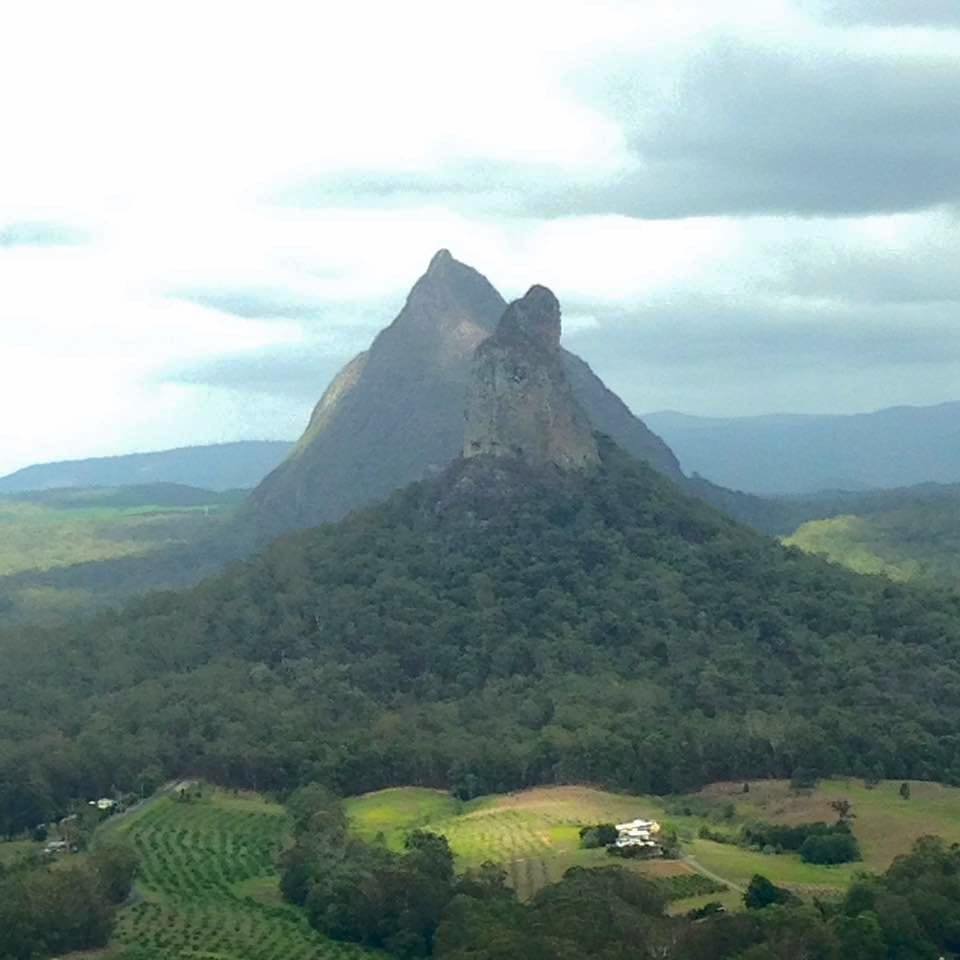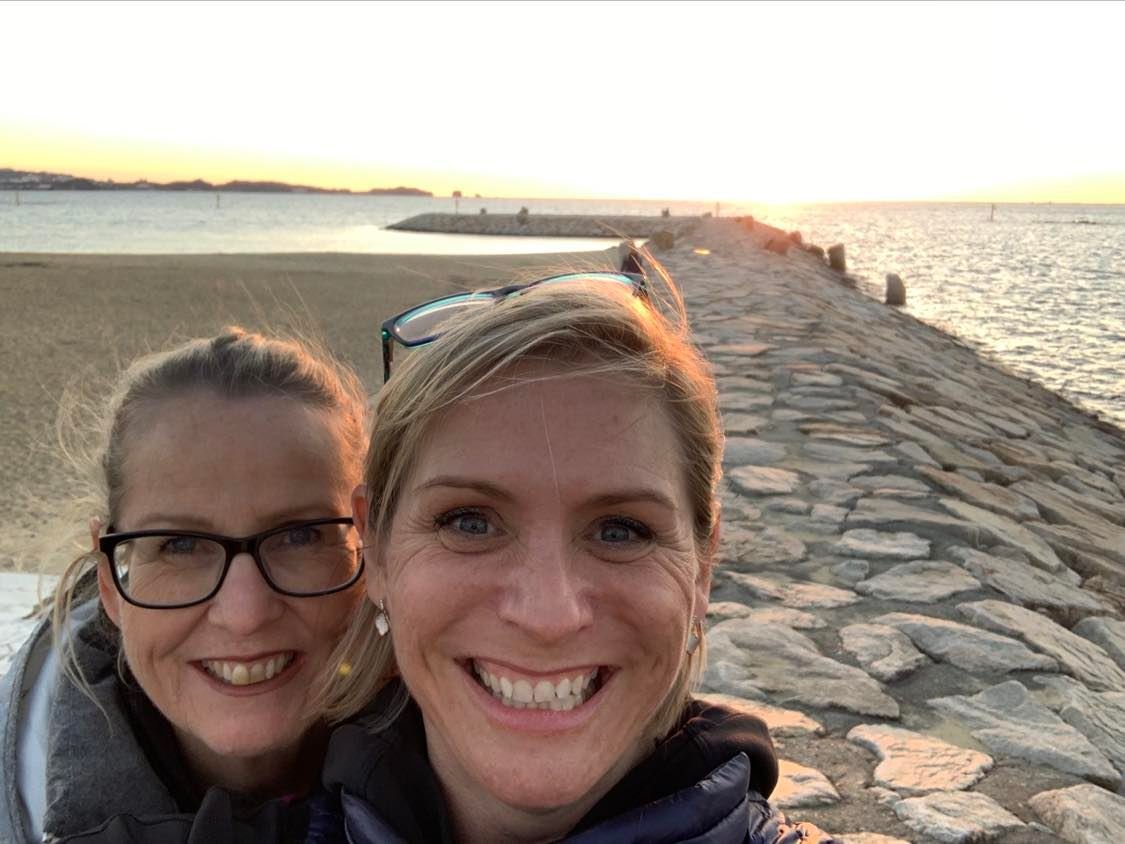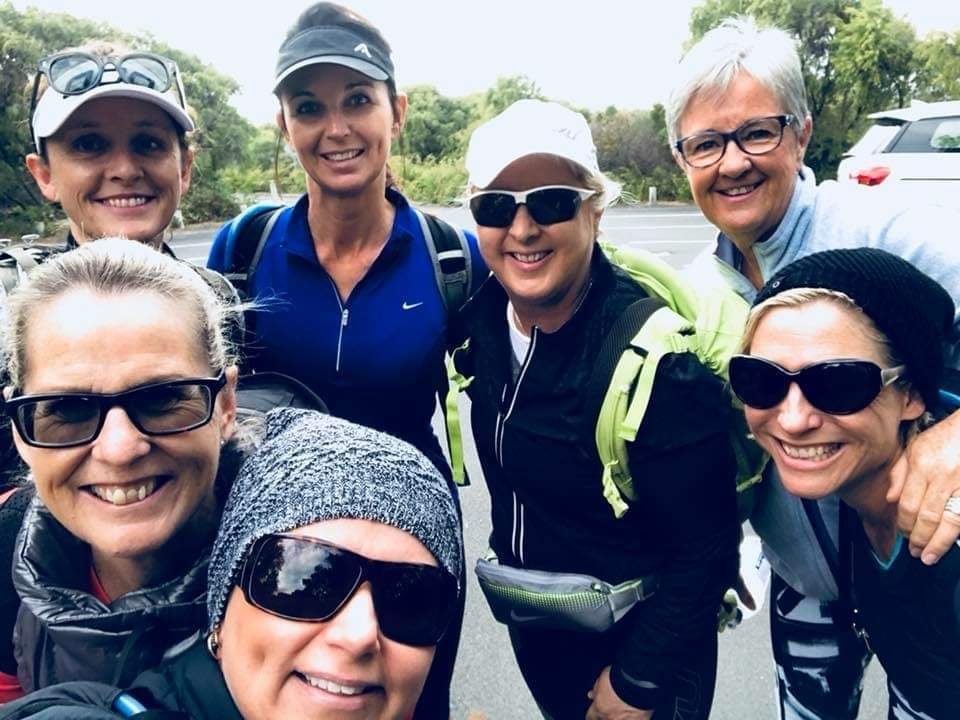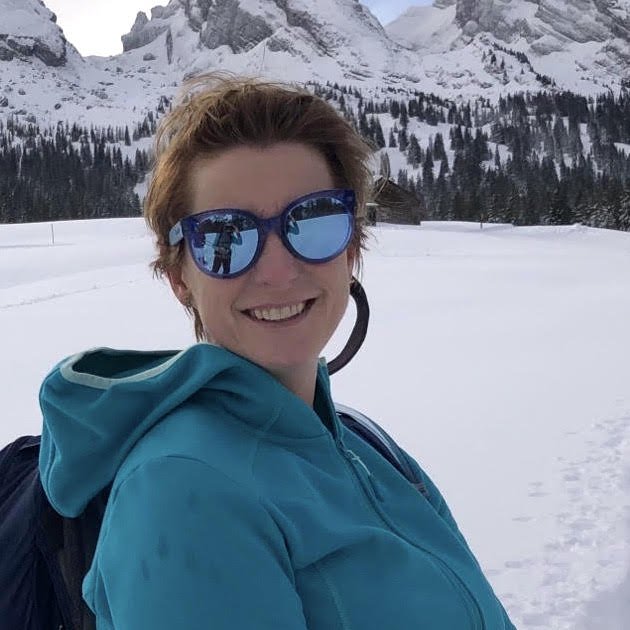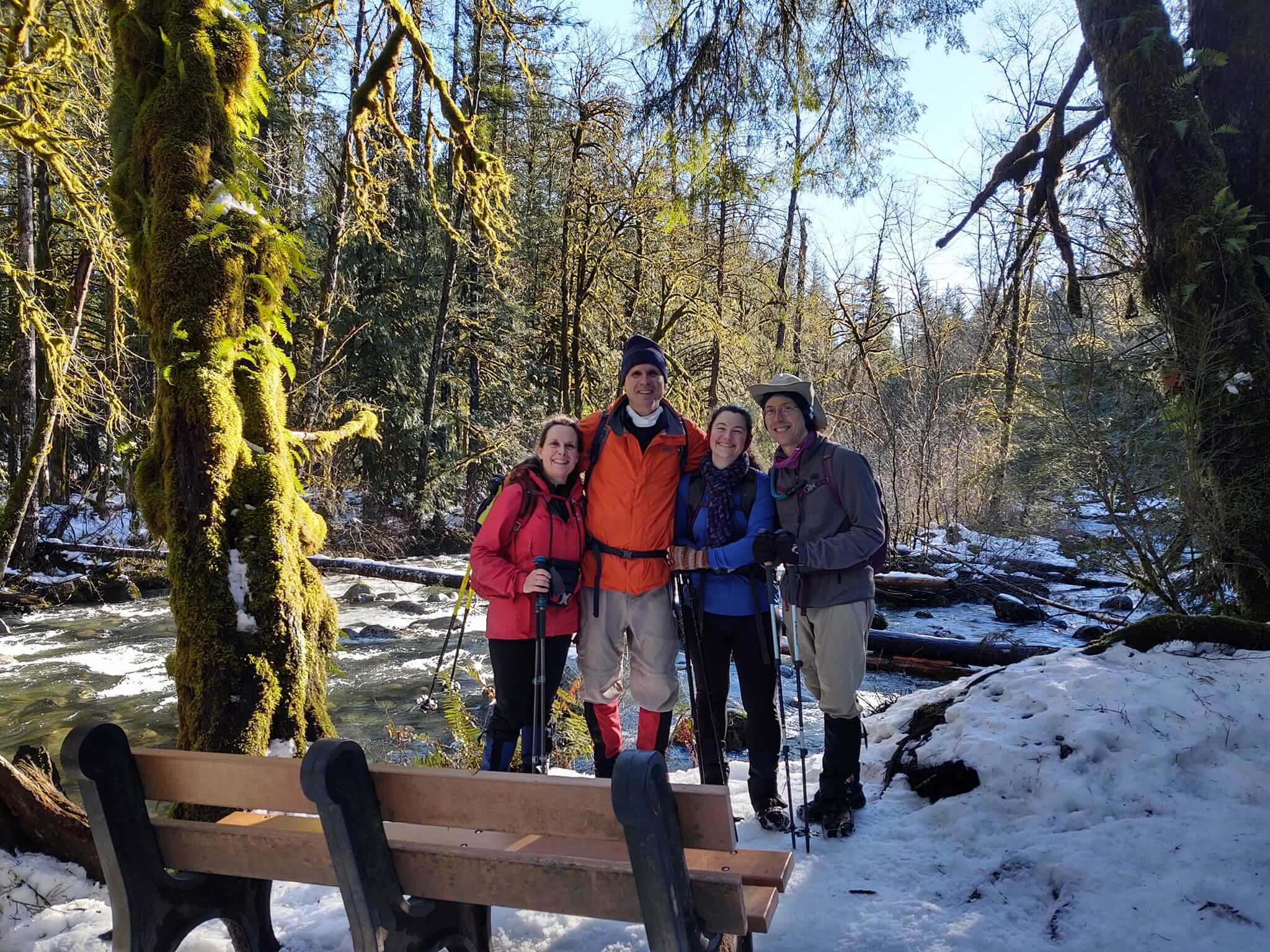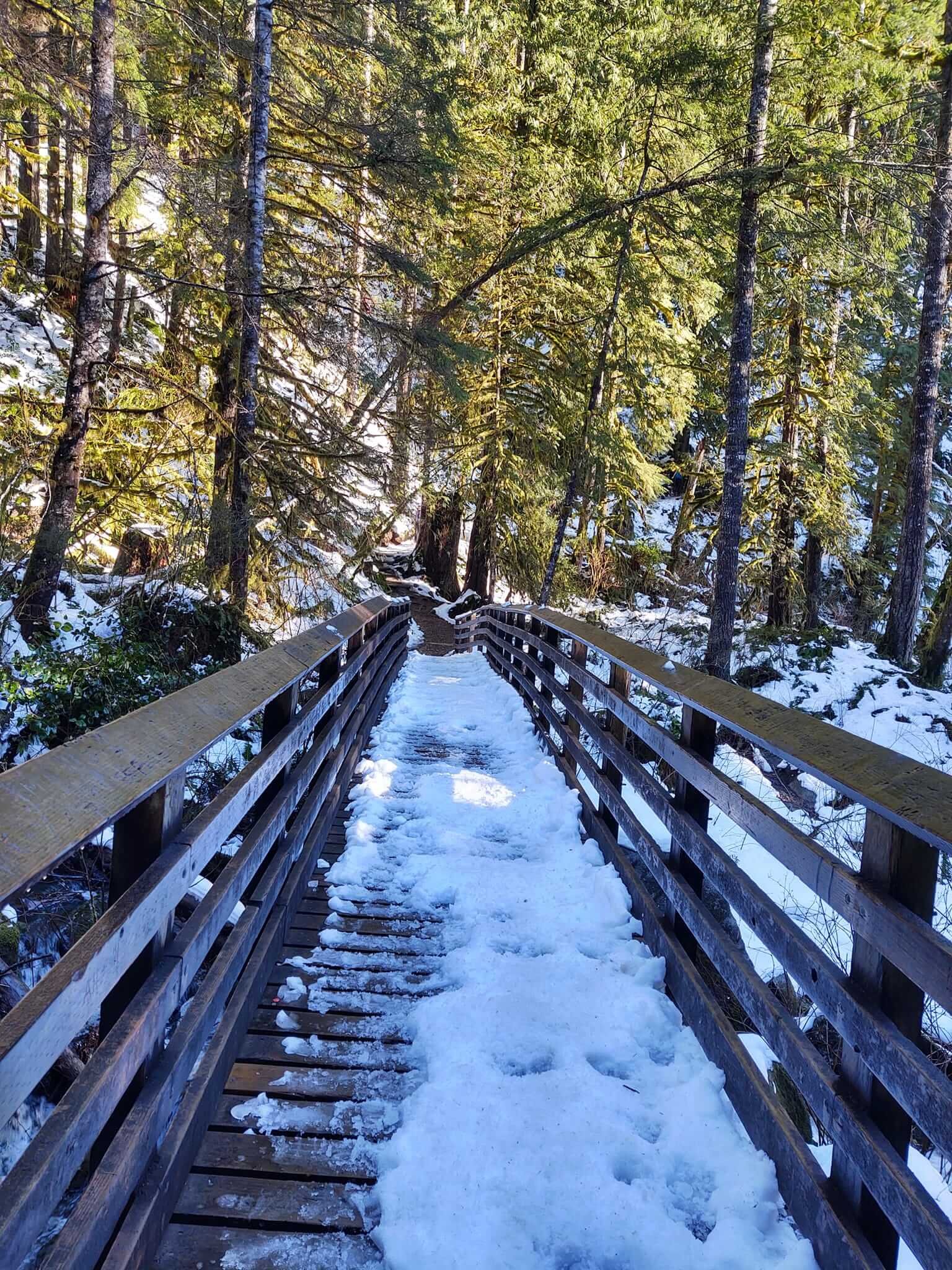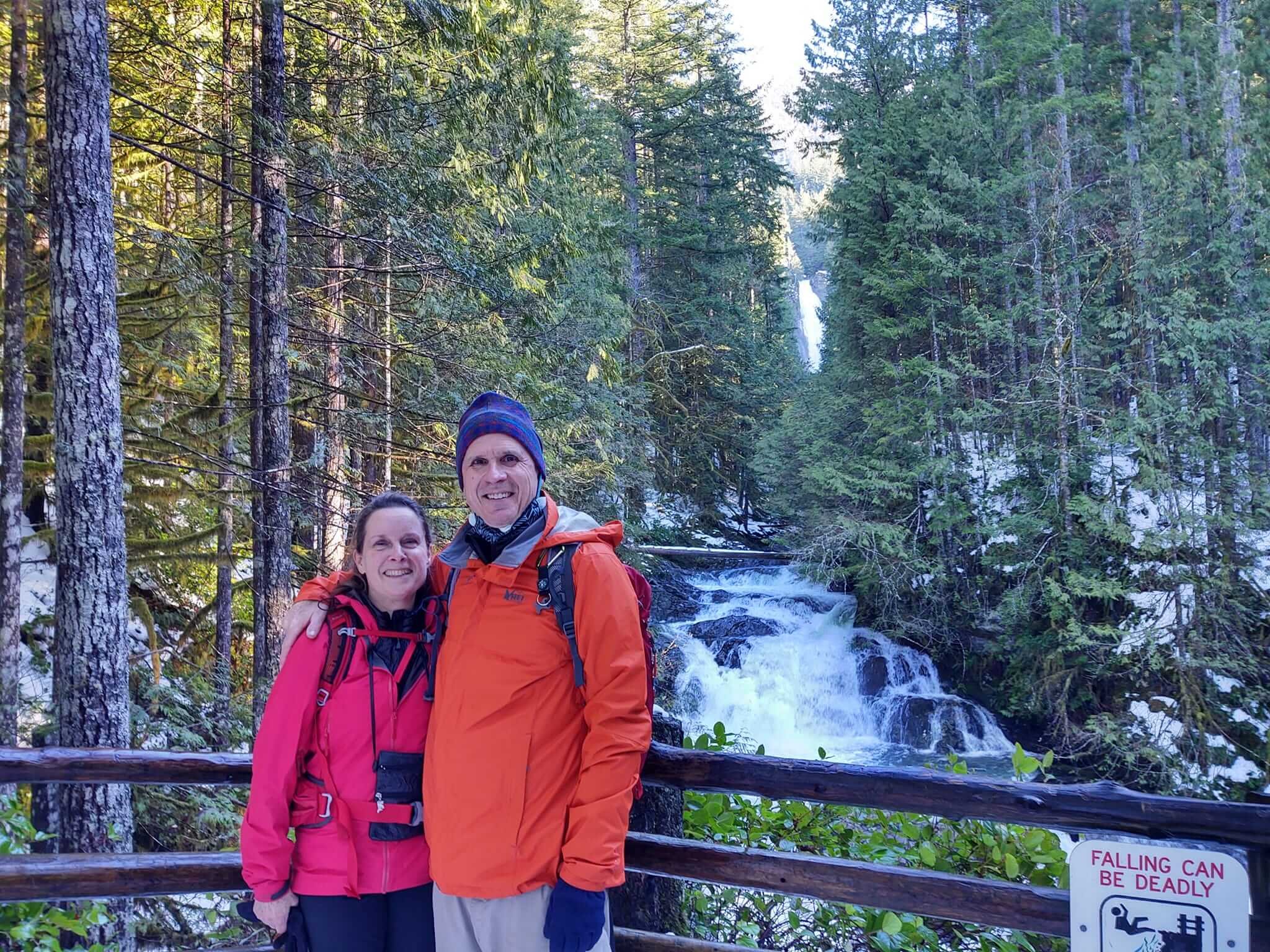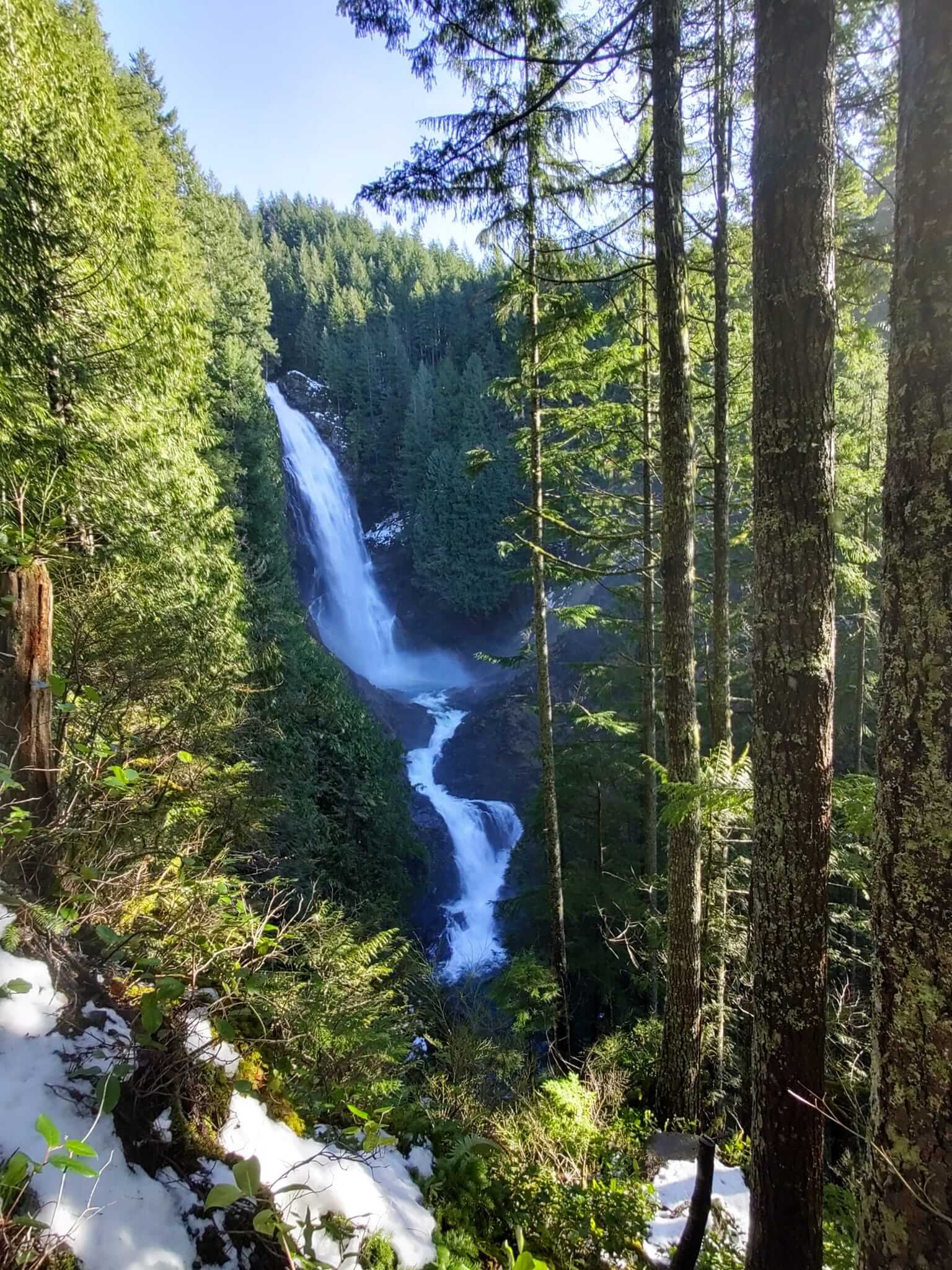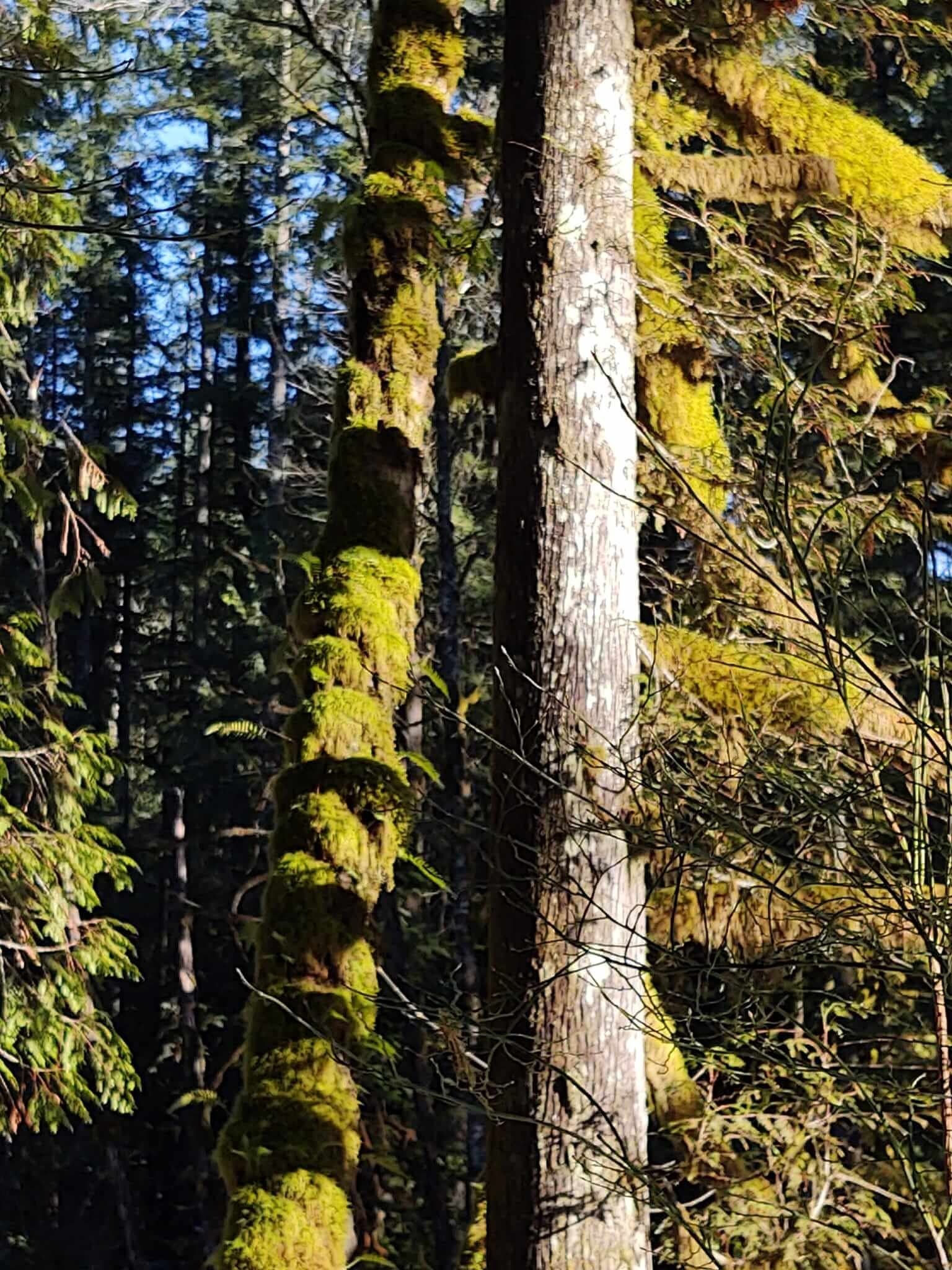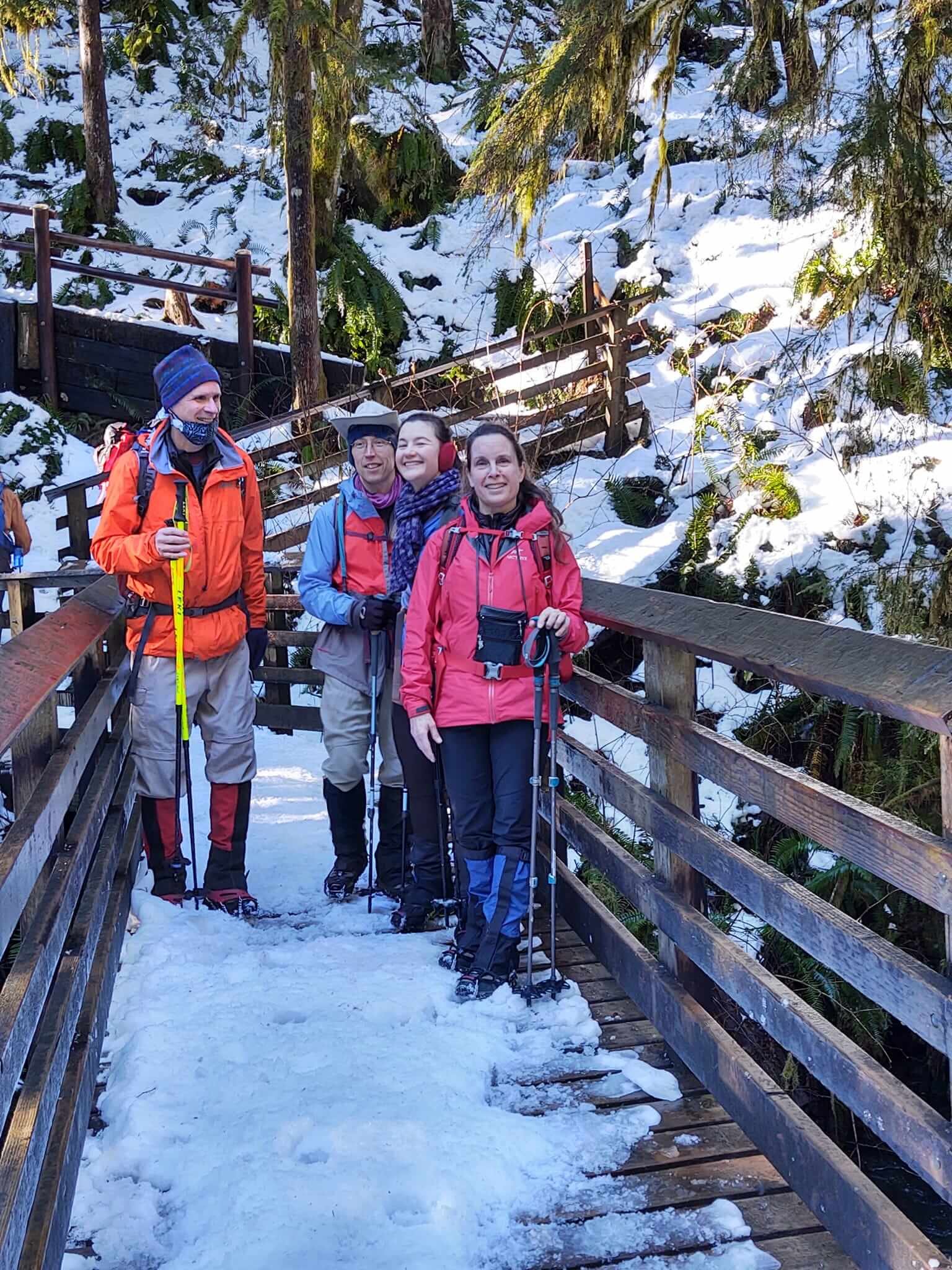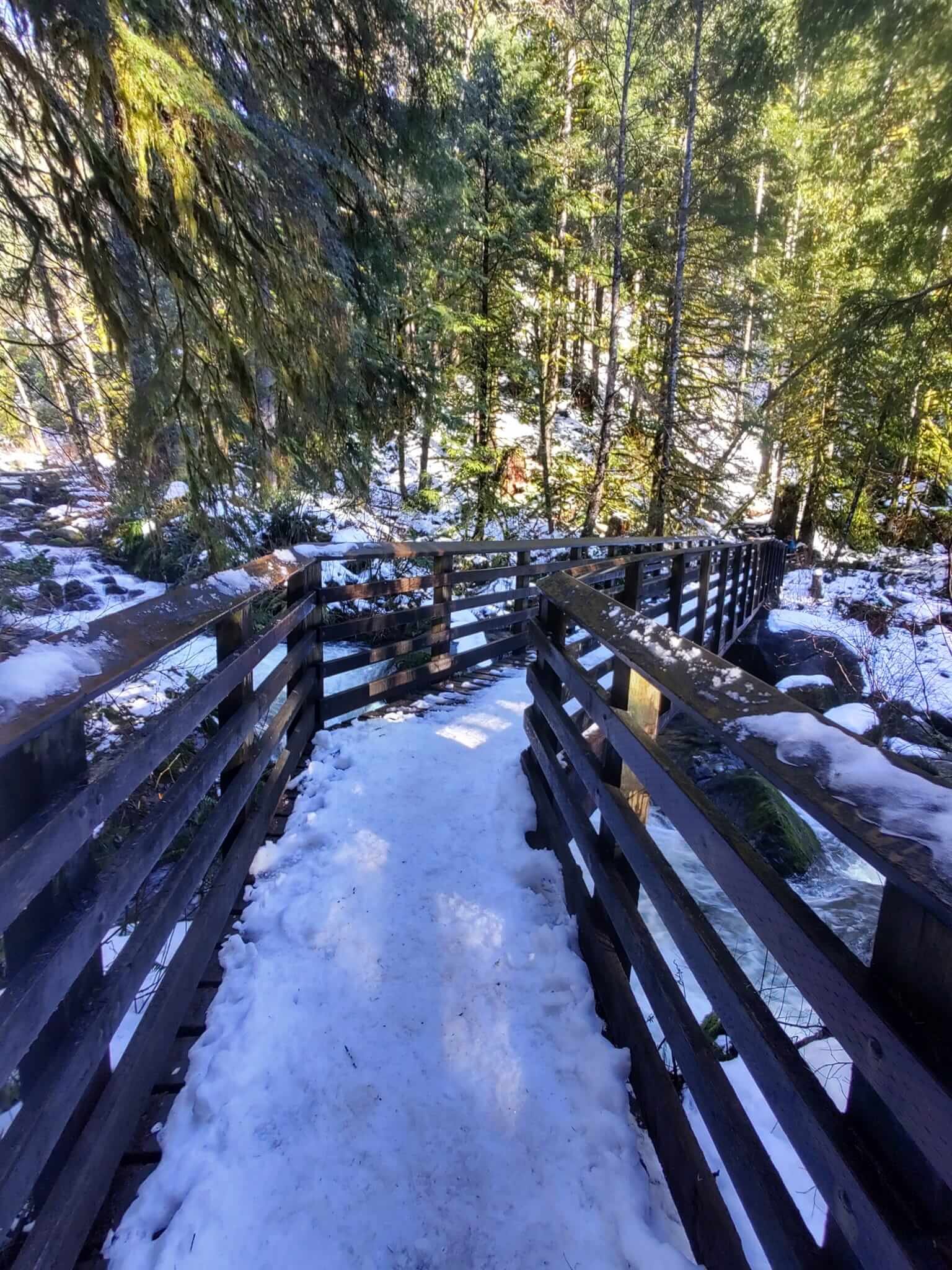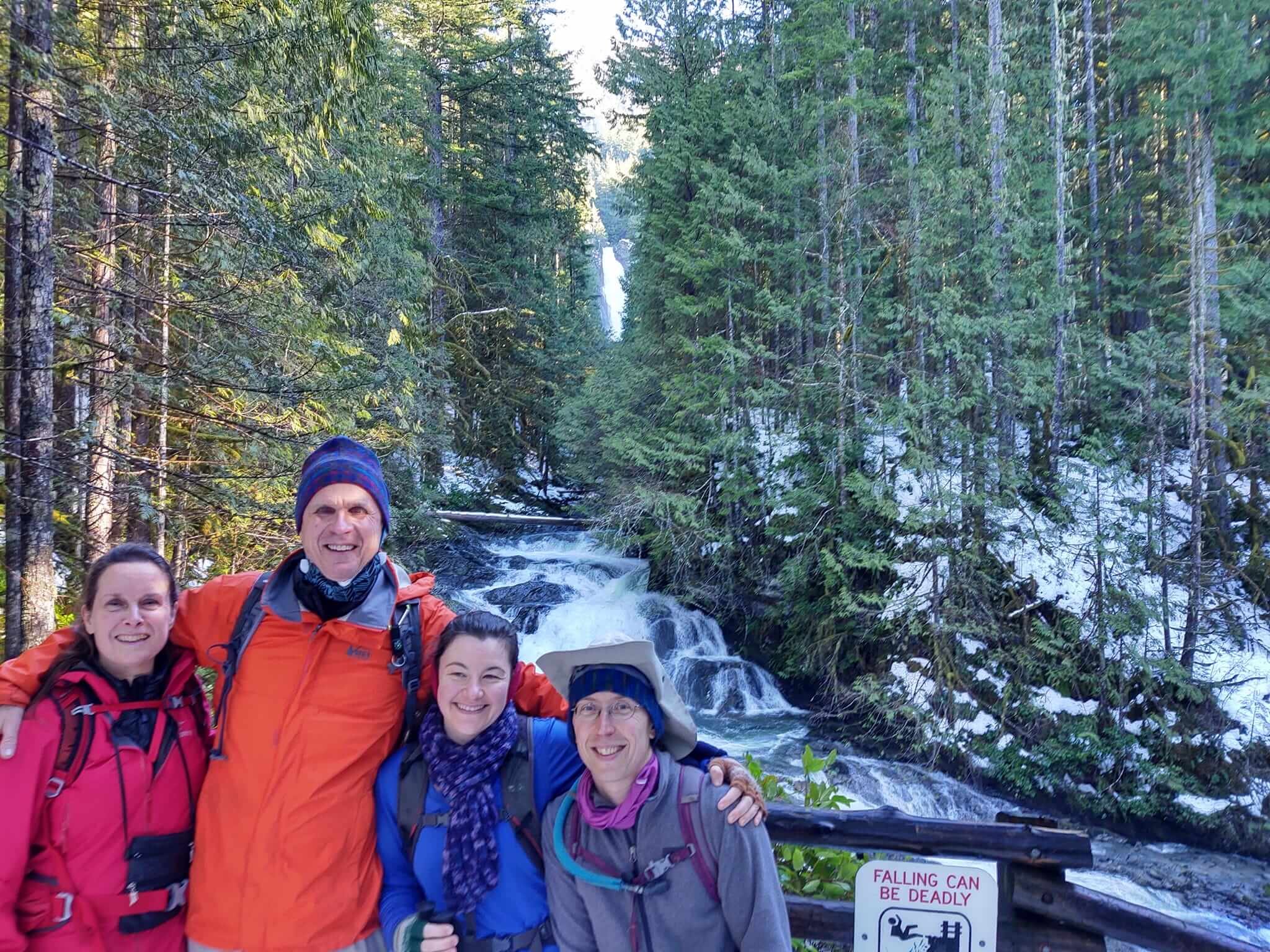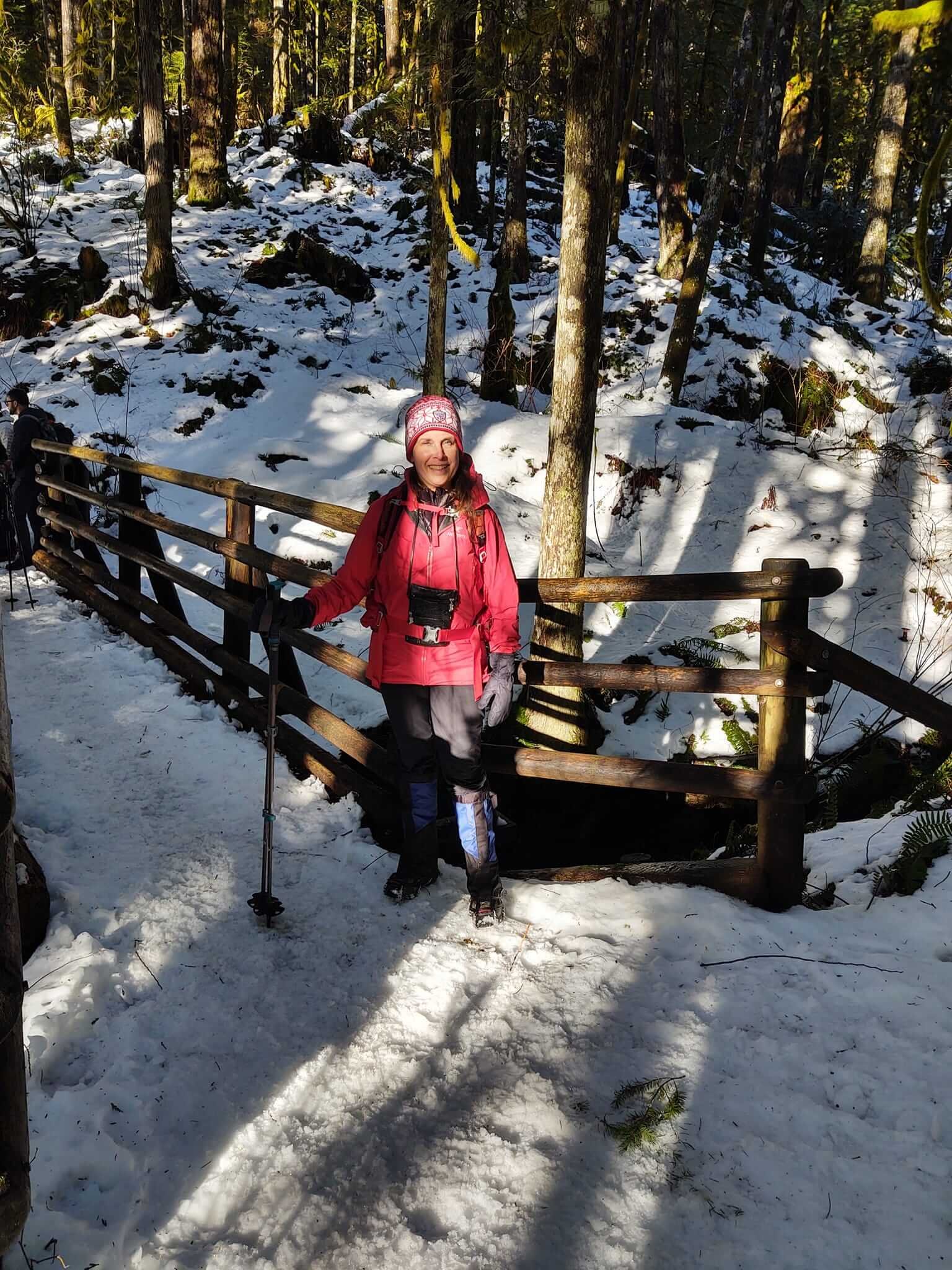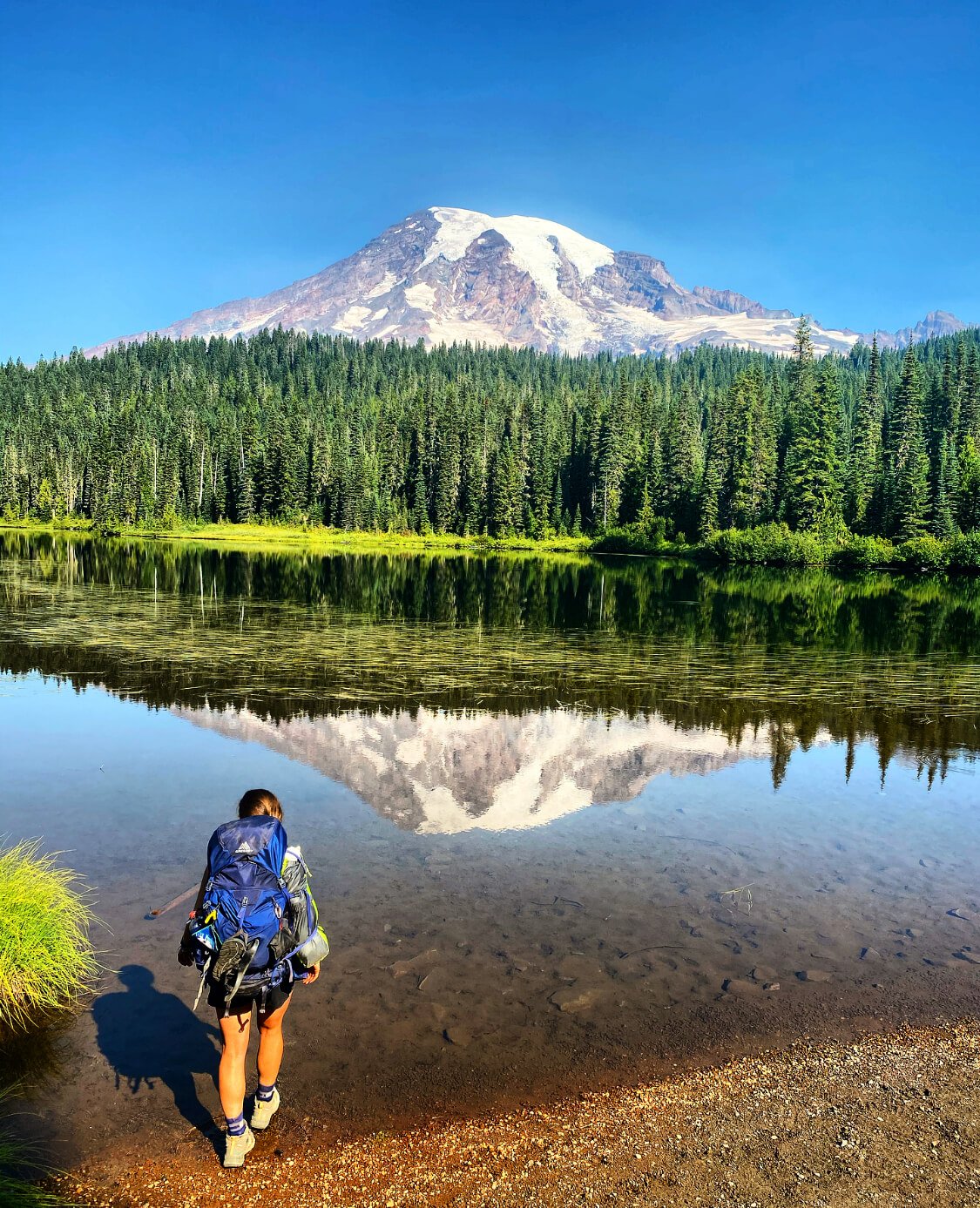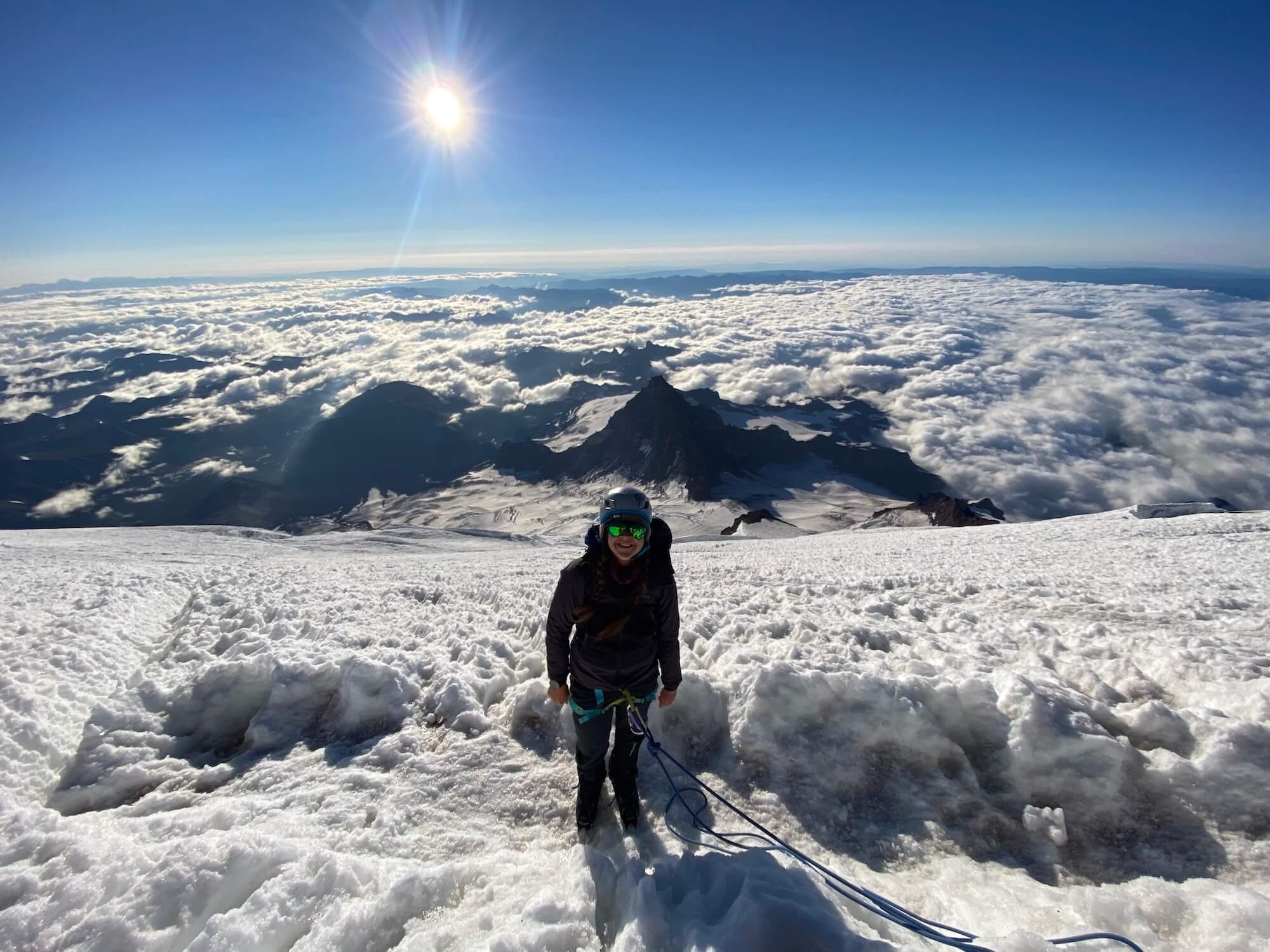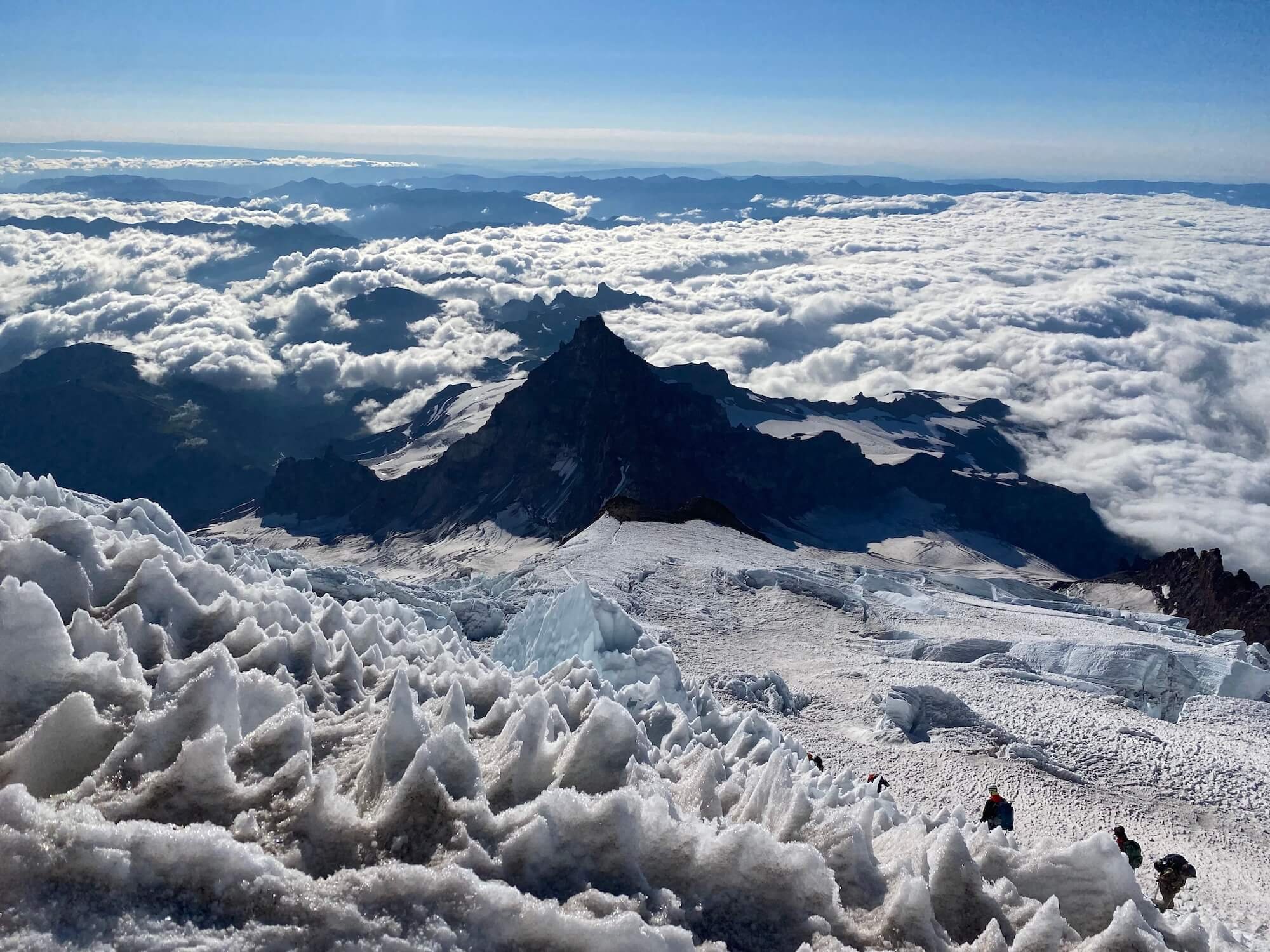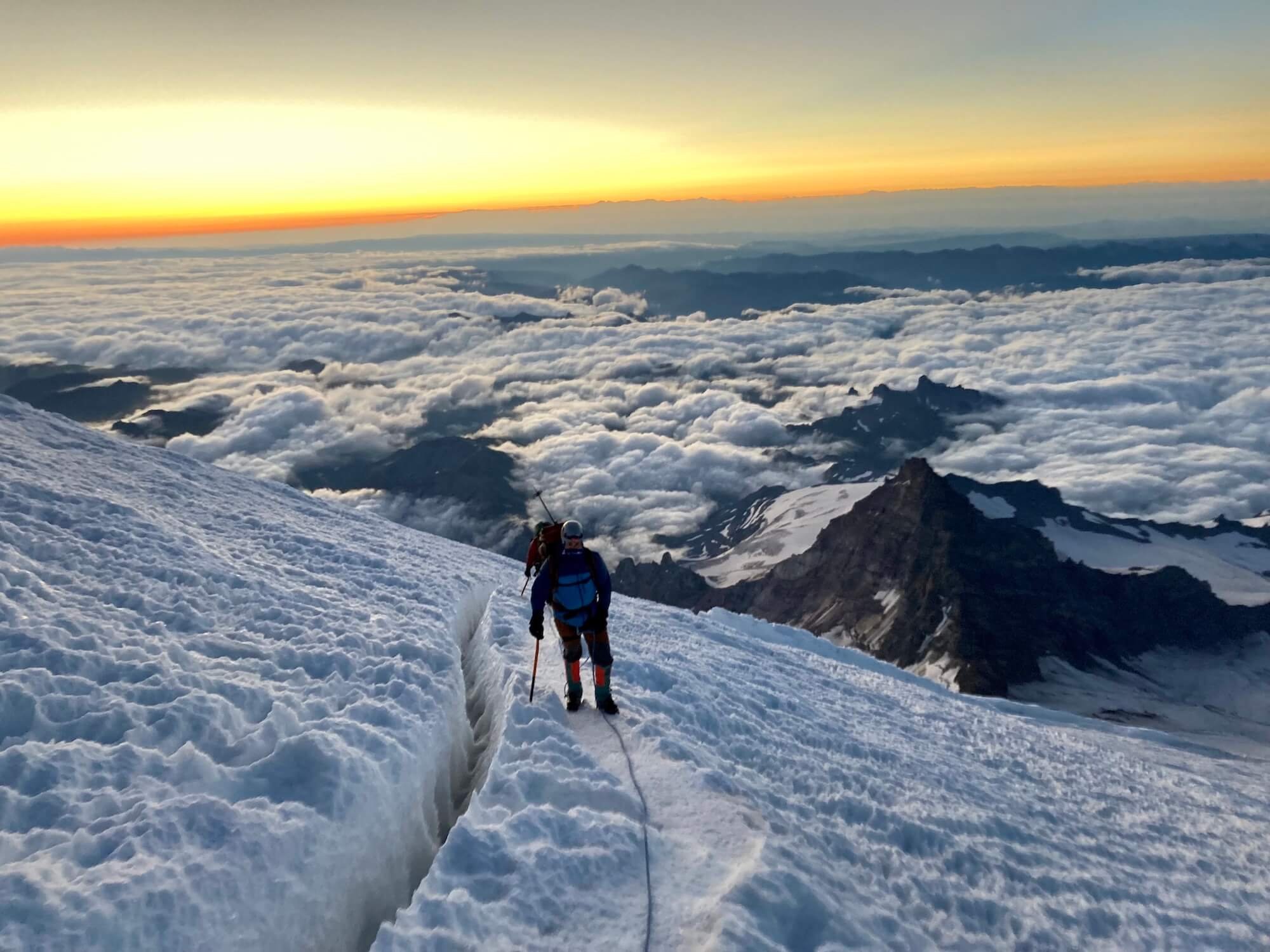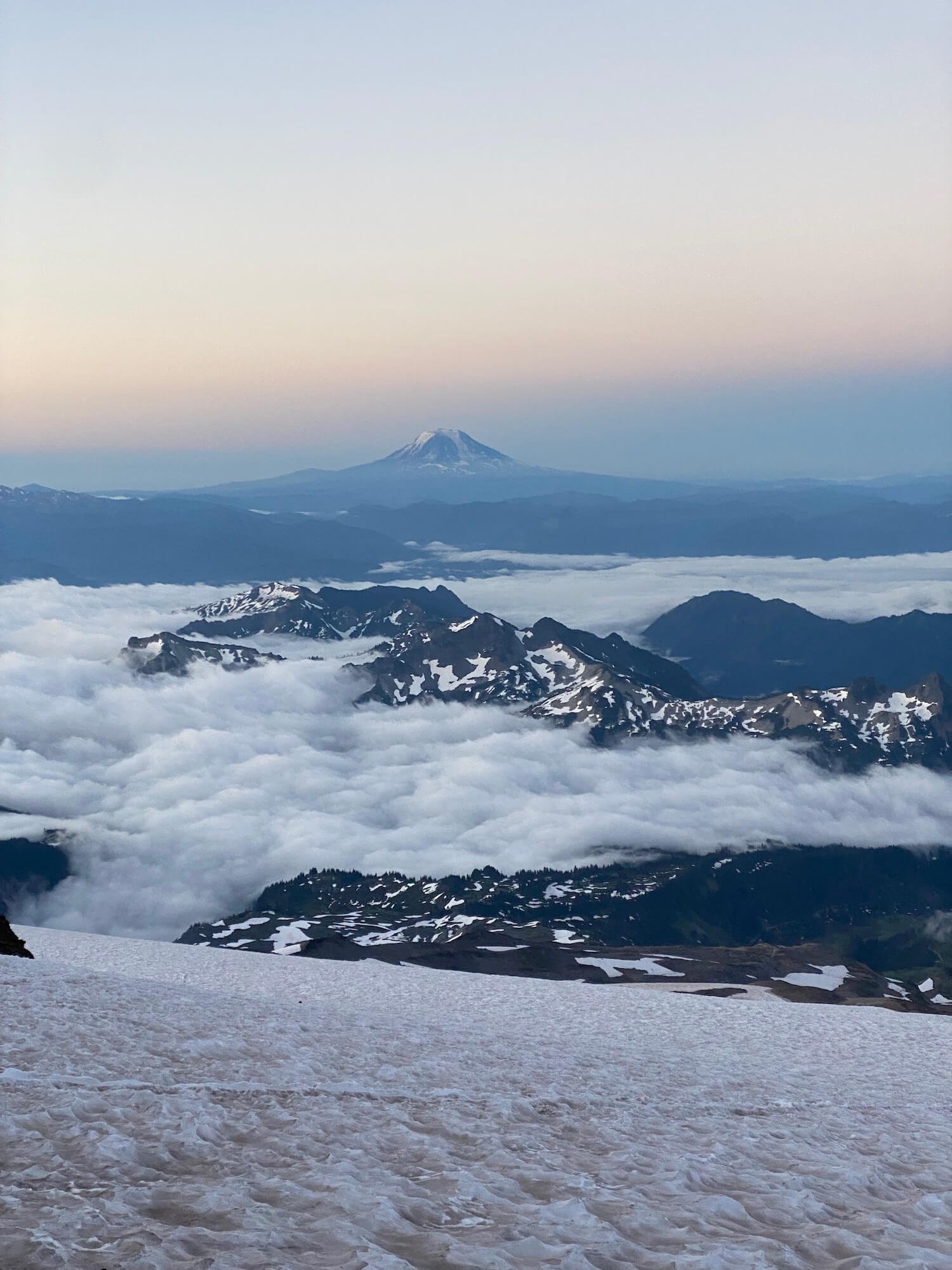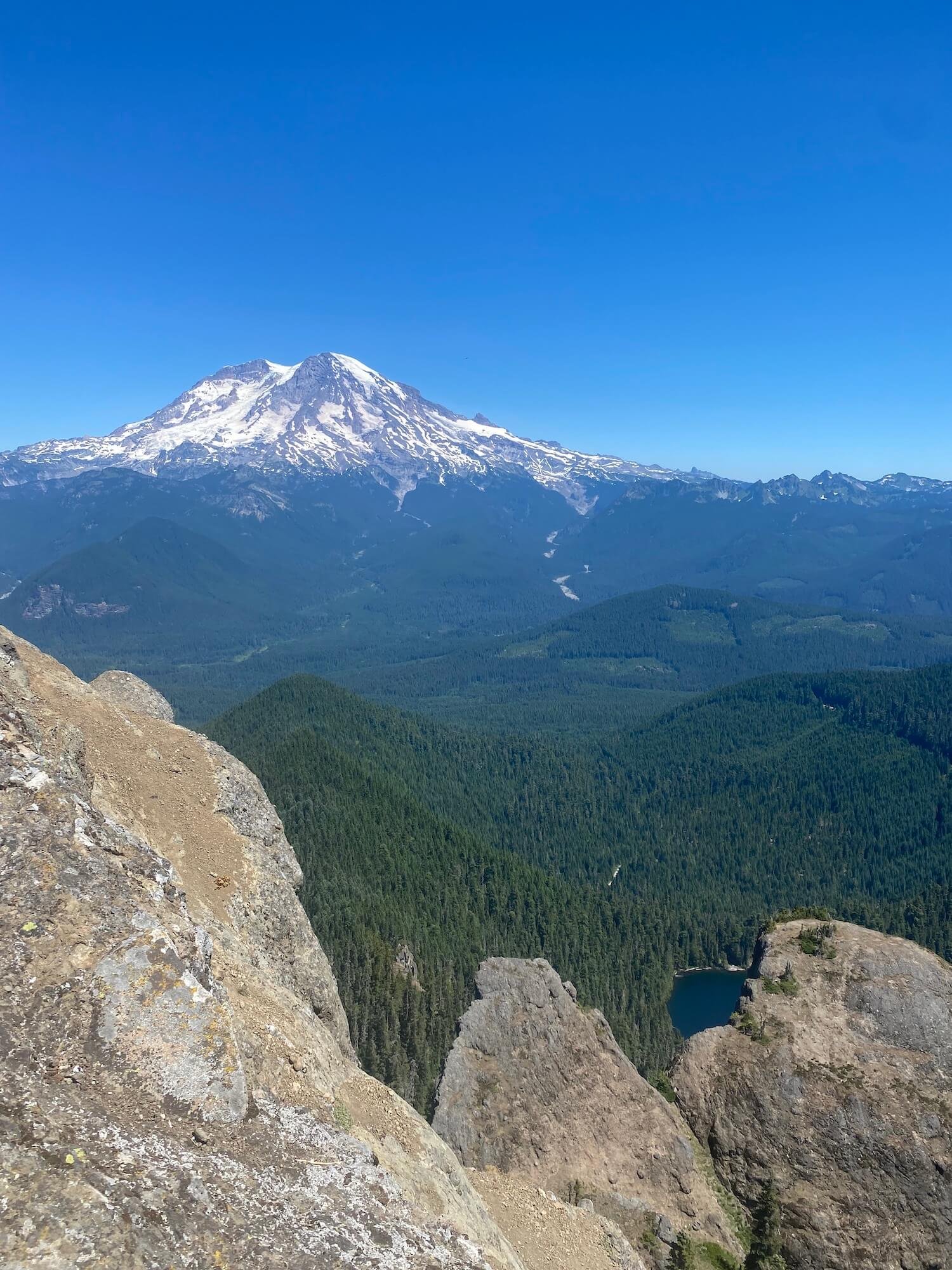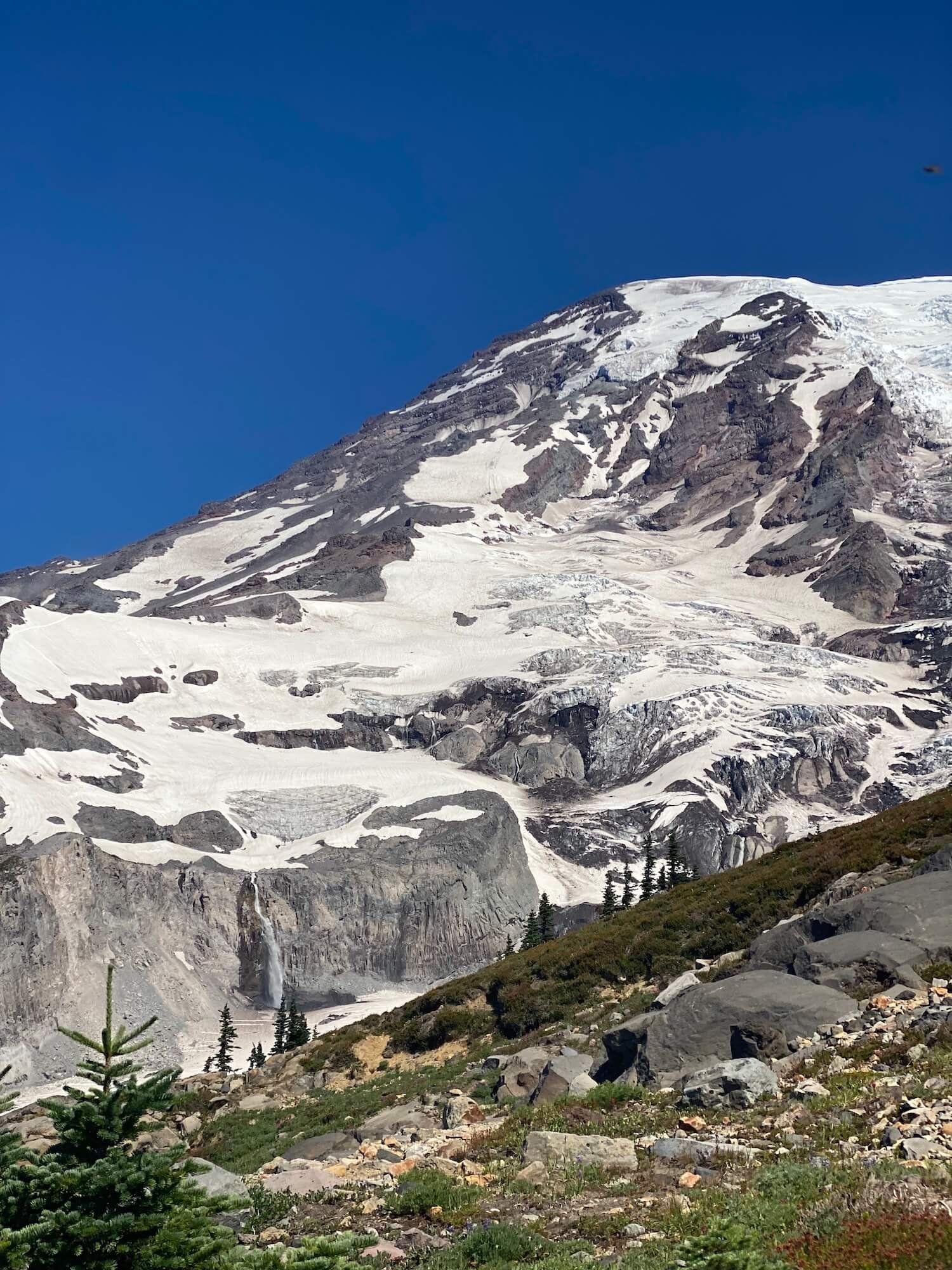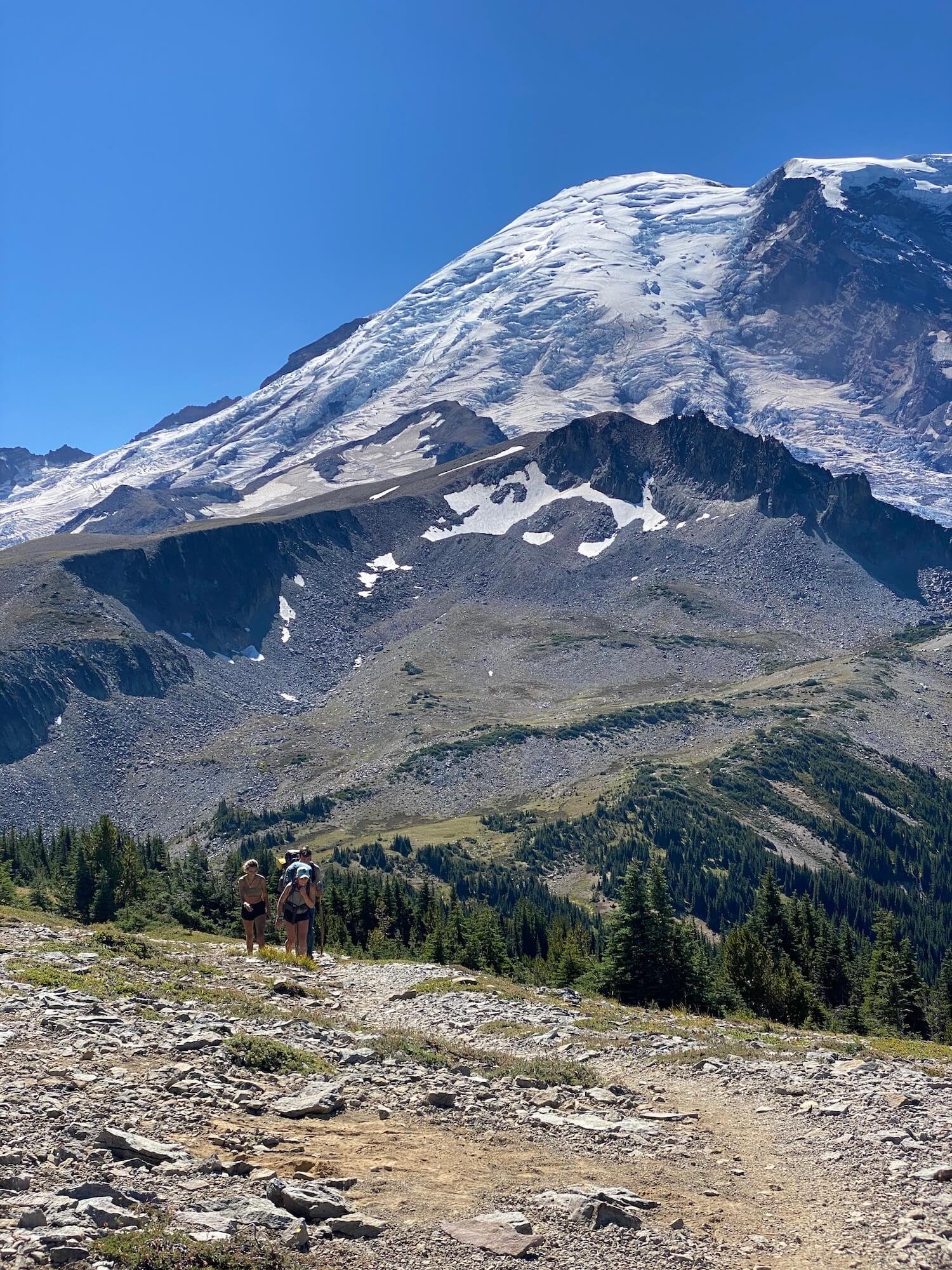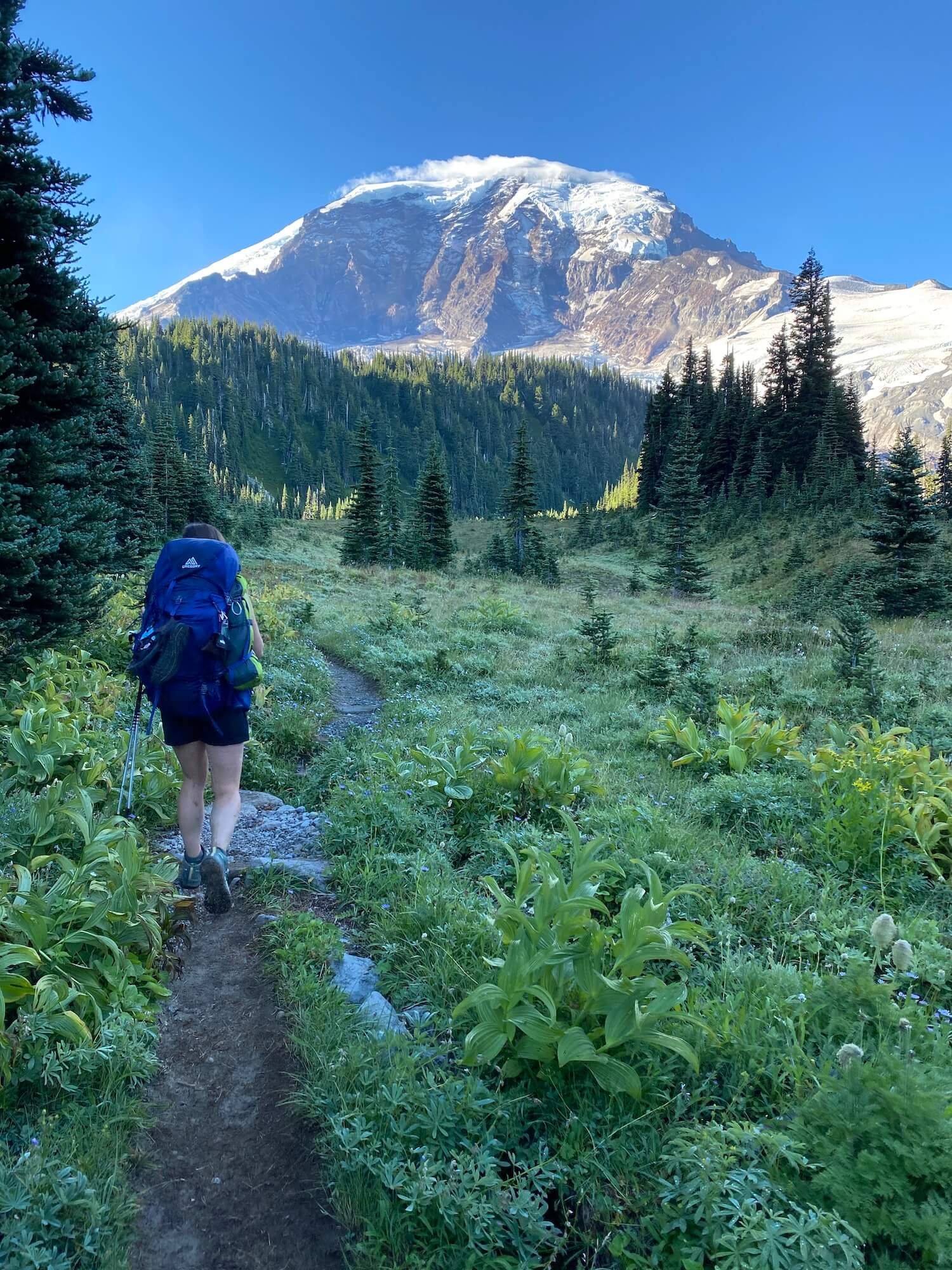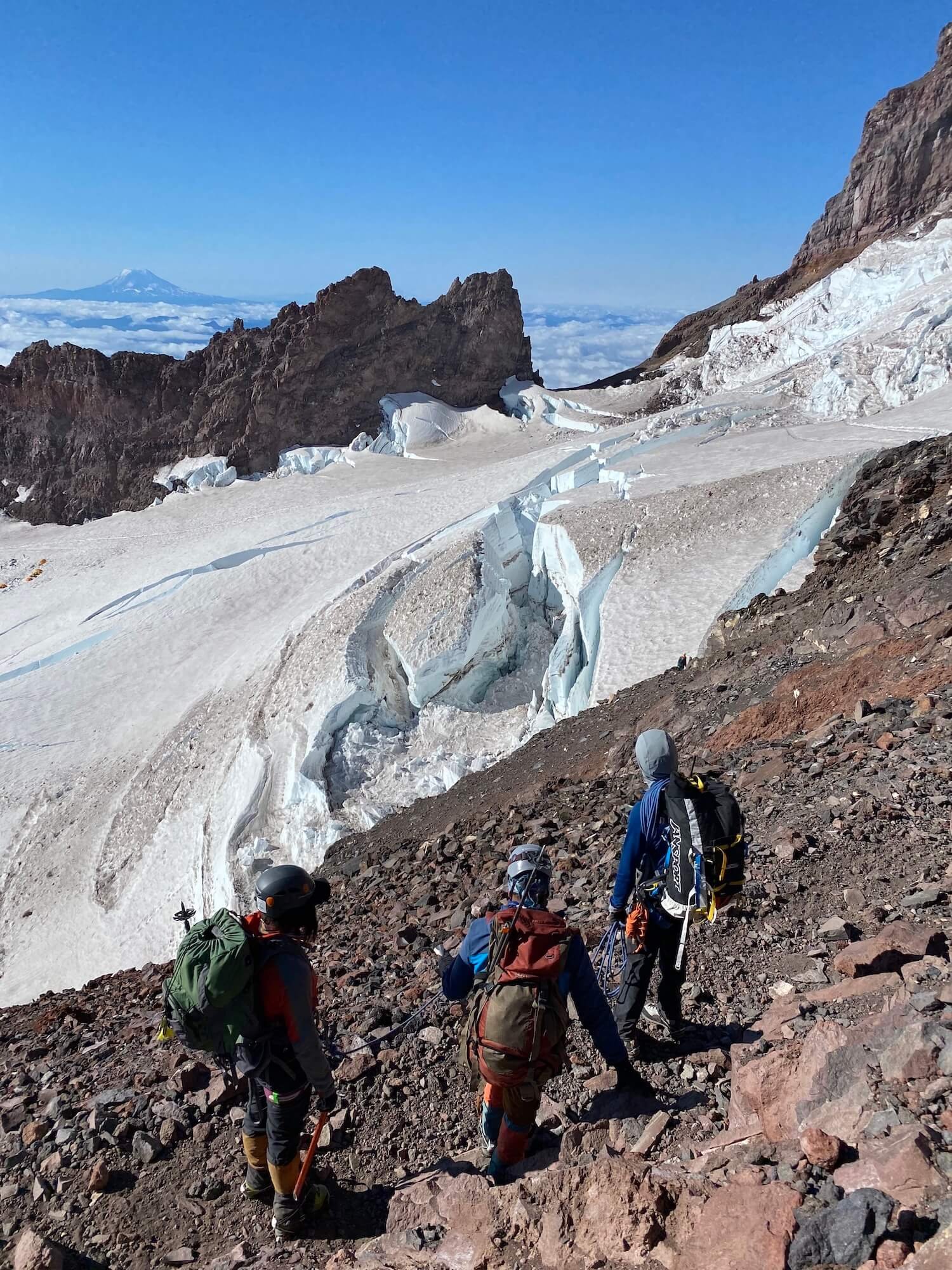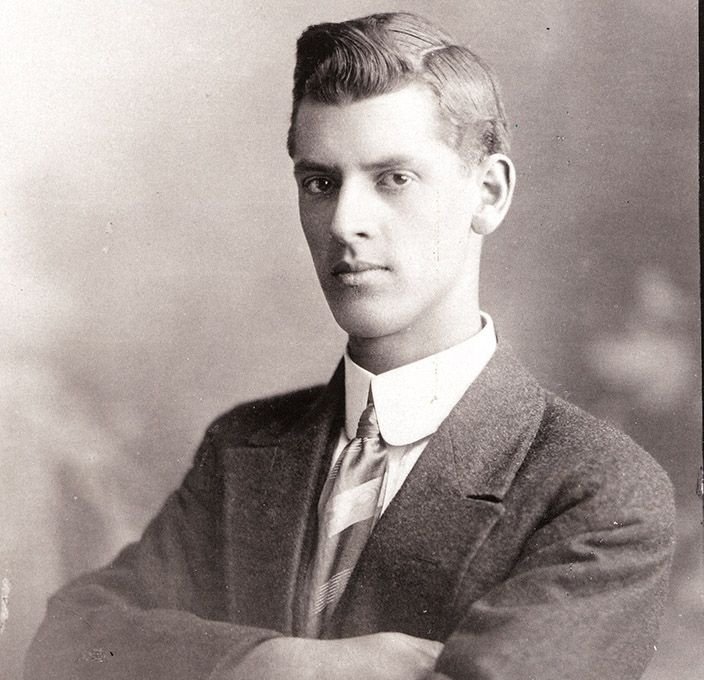Meg completed the Tour du Mont Blanc in 2024 as a trail ambassador. This was her first solo thru hike. Read her top tips for hiking the TMB solo.
Hiking the Tour du Mont Blanc with kids
The Smith family hiked the full circuit of the Tour du Mont Blanc in July 2024, staying in gites, mountain huts, and hotels. They carried everything they needed on their backs (there was no luggage transfer). Read Meggan’s tips about preparing and hiking a multi-day hike with kids.
Hiking the Tour du Mont Blanc with kids
Attempting your first multi-day hike can be intimidating. Doing it with kids adds a layer of complexity. I hope in sharing our experience hiking the Tour du Mont Blanc with our kids (a 10-year-old son and a 12-year-old daughter) that you will have a better idea of what a trekking adventure in the mountains might entail for your family.
Of course, every child is different, and you know your child(ren) best. Our family was already fairly active, and most family vacations involved some physical activity, especially hiking when exploring the beautiful National Parks across the United States. However, none of us had completed a multi-day hike, and most of our hikes in the Eastern United States did not exceed 1,000 ft elevation gain, so hiking the Tour du Mont Blanc (TMB) in the Alps was going to stretch all of us physically and mentally. My kids are also good at following directions, so I felt reasonably confident that if we told them to “stop” on the trail, they would do so (we also practiced this on our training hikes).
Below are tips and lessons from our family’s experience preparing for and hiking the TMB with kids. I hope they are helpful to other families (or individuals) who are considering making the trek. It truly is a trip of a lifetime!
preparation is key
Although preparation is important for everyone planning to hike the TMB, we were especially intentional as we embarked on this adventure with our kids.
Practice hiking trails, increasing distance and difficulty over time. This seems obvious, but it’s so important to help kids get used to hiking on uneven terrain, not only to strengthen their muscles but also to learn how to navigate technical spots and build their confidence in covering longer distances.
Practice wearing your gear. Runners always say: “Nothing new on race day” and we adopted that same mindset for hiking the TMB. We practiced using ALL our gear from our socks and shoes and undergarments to our outer layers. Rainy day on the weekend? It's the perfect opportunity to test our rain gear and new waterproof socks. A dusting of snow? That sounds like a great opportunity to wear our nano puff jackets and work on our footing in slippery conditions. Sunny and warm? It's time to test our new sunshirts, hats, and sunscreen. Test EVERYTHING – especially on longer hikes. My daughter discovered that a shirt that was fine on short and mid-distance hikes ended up chaffing her on double-digit hikes. Thankfully we had time to find an alternative that worked before setting foot on the TMB.
Practice wearing your backpacks. Our family was hiking hut-to-hut with no luggage transfer, so we needed to get used to carrying our packs with EVERYTHING. We got fitted for our backpacks at our local REI (an outdoor recreation store in the United States) which helped us identify the right size pack that fit each of us. We started carrying the 10 essentials on our practice hikes; but as we purchased our gear for the trip, we progressively added it to our packs, so we got used to the weight. This also allowed us to figure out before we got on the plane what we truly NEEDED vs what we could leave behind to help shed weight.
4. Practice hiking on similar terrain. We did not have the luxury of traveling to real mountains with elevation gain comparable to what we would experience on the TMB, but we did our best to simulate the trek. We tried to find hilly trails near us, and once we got comfortable with double-digit hikes, we completed a few back-to-back hikes on the weekends. Over a 3-day weekend six weeks before our trip, we not only tackled three double-digit hikes in a row, but we also stayed at a hostel for hikers along the Appalachian Trail one of the nights to practice sleeping in an unfamiliar location after a long day of hiking. It was a fabulous experience and gave us more confidence that a multi-day hike was achievable and enjoyable.
5. Practice strengthening your mental game. We found that hard training hikes helped build resilience, and struggles along the way were opportunities to learn what helped our kids push on (we also figured out what did NOT motivate them... ahem, daddy lectures!). We quickly discovered that eating snacks early and often helped keep our kids cheerful and moving. If we waited until they got the hangries, it would take a while for them to recover. We also watched a lot of TMB videos on YouTube so they could see the big climbs and also get a feel for the types of places we would be staying on the trail. While they thought this was boring at the time, knowing what to expect seemed to help a lot once we were on the trail.
on the trail
Time to put all that preparation to use!
Take breaks. Prepare for lots of short breaks. Unless you have terrain and elevation gain similar to the Alps nearby, the TMB will probably still be challenging even with your training. Expect your kids to want/need lots of short breaks. These breaks are a great opportunity to make sure everyone is staying fueled and hydrated, adjust layers, and reapply sunscreen (side note: you’ll need more sunscreen than you might expect!) --- and provide the time to take breathtaking photos while you catch your breath.
Keep everyone fueled. Take advantage of the food on the trail. Have I mentioned that my kids do better when they have snacks? We usually opted to purchase two packed lunches from our accommodation (remember to order them the night before!) and we would either snack on them throughout the day or use them as our main mid-day meal (depending on what the food availability looked like for that section of the trail). This worked well especially when combining our packed picnics with short stops at refuges on the trail for additional food and drink (NOTE: I posted what we spent on the trail in my daily Instagram recaps to give an idea of cost). Another favorite thing we did was buy a baguette from the local boulangerie and tear off hunks of bread to nosh on while hiking.
3. Make adjustments as needed and as soon as identified. If a sock feels weird in your shoe, stop and fix it – don't wait until it becomes a bigger issue. Too warm? Stop and shed a layer. The time spent making adjustments to be as comfortable as possible is well worth it – especially if the change avoids blisters, heat exhaustion, sunburn, etc. Kids, or at least our kids, may recognize an issue but struggle with knowing how to make adjustments. Practice hikes can provide opportunities to learn how to adjust (especially your pack), but it is so important once you’re on the tail. Even small adjustments can make a day on the trail so much more enjoyable; for instance, our daughter quickly got into the habit of dipping a handkerchief in the cool streams that we crossed to cool off her face and neck.
4. Plan for distractions. While I wish I could say our kids were completely enthralled with the beautiful views of nature the entire time, the truth is, while yes – they had several moments of stopping to take pictures and marveling at the breathtaking landscapes – they also got bored. Our youngest found that he could deal with the hard climbs by having his dad tell him the storylines of various movies (one rainy day we were treated to a recap of the “Back to the Future” trilogy....). That did not work for our tween daughter, however. We figured out halfway through the trip that she was much more pleasant if she could listen to music on the hard climbs. Thankfully I brought my Shokz open-ear headphones. The complaining stopped if she could listen to music on the inclines. We let our son use them to listen to an audiobook during the long descent to Les Houches on our final day, and it added a pep to his step. For our next multi-day trek, I will probably make sure we have two sets of Shokz (I like them because they are open-ear, so you can listen to your audio while still hearing those around you – an important safety measure!) with audiobooks and music pre-downloaded to our devices.
5. Take note of shortcuts. While we only made use of a few of the shortcuts available, I did take note of the various public transportation, cable cars, and shortcuts ahead of time, so if we had bad weather, were short on time, or someone wasn’t feeling well, we had options. We planned to take the Bellevue Cable Car on the first day and were happy we did so – especially since we did the Col de Tricot variant. Taking the Delone Cable Car was a huge plus for my daughter as we headed down to Courmayeur for a rest day. I will say that this is where customized maps from The Hiking Club combined with the Organic Maps app were super useful – you can see public transportation options – but also alternative routes. On our last two days on the trail, less-than-ideal weather had us adjusting our routes on the fly, and I was so thankful that we could see what options were available to us when we needed to make decisions in the moment.
6. Staying in accommodations. We were fortunate enough to book private rooms or 4-person dorms for all nights except two on the trail. This worked well for our family, as it allowed the kids to be a little more comfortable after a long day of hiking. We still got the mountain hut experience with the shared meals and (often) shared restrooms. Our two evenings in shared dorm rooms were fine – thankfully we had lovely roommates both times (6-person dorm rooms). But the nice thing about hut-to-hut hiking is that even if you don’t love the place you’re staying at one evening, it is only for one night and you’ll have a new place to look forward to the next night.
Reflections
While hiking the TMB is not for everyone, with the proper preparation and a willing attitude, it is possible to complete the trek (or part of the trail) with children. I loved watching my kids grow on the trail. They adapted to trail conditions, problem-solved, tried new food, and met people from all over the world – all while hiking more than 100 miles over 11 days. Was there complaining? Yes. Were there tears? Yes. Were there sore legs? Yes. But there were also memories made, relationships formed, and fears conquered – it was the trip of a lifetime. All of us learned to be more resilient; we pushed through pain and fatigue and learned each day that we could do hard things.
Upon returning home, we returned to our familiar trails of the AT and started reminiscing about the Alps... My teen daughter started talking about which sections of the TMB she would want to repeat when we return in a few years – as well as what other trails she would like to explore in the Alps.
Time to start planning our next adventure!
Follow Meggan on her Instagram for more family hiking content: @mountainsarecalling_wemustgo
Tour of Jungfrau Trip Report
Sam McGrady and Steve Smedley live in Matlock, Derbyshire, and are seasoned multi-day trekkers across Europe and the UK. Focused on travelling as light as possible (no camping), they undertake at least one long-ish trek each summer using mountain huts and small villages for accommodation. Previous trips have included Walkers’ Haute Route, GR11 (Spanish Pyrenees traverse), Tour de Mont Blanc, Tour de Monte Rosa and AV1 (Dolomites).
Summer 2024’s adventure took Sam and Steve back to Switzerland to undertake the Tour of Jungfrau Region (JFR) – which whilst following the ‘official’ route most of the time, they made their own with variants, side trips and some extra days thrown in. It should also be noted that Sam and Steve are vegetarians, so references to food should be taken in that context and explains the obsession with rostis on this trip!
Trip summary
13 hiking days
1 rest day (at Kleine Scheidegg)
Total distance – approximately 196 km (122 miles)
Total ascent/descent – 12,390m (40,650 ft) gain/loss
Start/finish – Wilderswil (Interlaken), Switzerland
General observations on the Tour of Jungfrau:
It’s very popular and busy – not so much the trail itself but there are lots of very accessible points most days via an excellent integrated public transport system (trains, cable cars, ski lifts, buses) resulting in hoards of ‘tourists’. It’s not a trek for getting away from it all.
The walking is straight forward, nothing technical. Likewise route finding simply isn’t an issue. The amount and variety of accommodation options mean you can make your days as long or short as you want. Don’t feel the need to stick to the traditional route and stages, busk around the template.
It is an area of outstanding and amazing scenery – Eiger, Monch and Jungfrau are omnipresent and undoubtedly the star attraction, but this should not diminish the contribution of many other outstanding mountains that will be familiar to alpinists but not the average hiker or tourist. There are also numerous glaciers to see and the landscape is varied and interesting. When we went the alpine flowers were abundant and a joy to see. Take your time, stop and stare.
TOUR OF JUNGFRAU LAUNCHING SOON
Day 1 (3 July) – Interlaken to Breitlauennen station
9km, 1076m up, 2 hours 40 mins
Having flown to Geneva and then taken a train to Interlaken the previous day, we started our TJR with a great breakfast in the Alphorn hotel in Interlaken, including fresh fruit and hard boiled eggs. We walked across the Ruegen to Wilderswil (a lovely village in contrast to the somewhat tourist-hammered Interlaken) then set off walking uphill through forest to the cog railway station at Breitlauenen, which has a fab little café.
As the onward path to Schynige Platte was closed due to rockfall we took the cog railway for the remaining relatively short distance – which was fun! After checking in to the somewhat swanky Berghotel Schynige Platte (the only show in town) the cloud was down and the rain had started. As we’d reached our destination for the day this wasn’t a problem and we had a decent meal in the hotel looking out at cloud and rain where one of the best views in Switzerland should have been!
Panorama Schynige Platte to Grosse Scheidegg
Day 2 (4 July) – Schynige Platte to Grosse Scheidegg via Faulhorn
24km, 1200m up, 6.25 hours
We woke up to completely clear skies, sun and amazing views of the full mountain range opposite – Eiger, Monch and Jungfrau, which would accompany us on much of this trek. After a great breakfast of eggs, cheese and local honeycomb, we packed up and set off, taking our time for the first few miles to stare and take photos.
Spring flowers were abundant. The weather was sunny but with a fresh cool wind. The route took us across myriad snowfields which really slowed us down. However, we had absolutely amazing views all the way – Eiger, Monch and Jungfrau to the right and Brienzsee below us to the left - and even saw an eagle near the Faulhorn (today’s high point).
Views all the way – Eiger, Monch and Jungfrau
The route wasn’t too busy until we reached the Bachsee lakes, which were teeming with visitors who had come up on the gondola to First. We were happy to leave the selfie-fest behind at First (the official end of today’s stage but not our end point) and took a solitary walk to Grosse Scheidegg in increasing cloud. What an amazing spot - right underneath the Wetterhorn.
Again, the Berghotel Grosse Scheidegg is the only accommodation here, and we had a cosy double room. The food was good: salad plus rosti with fried vegetables. After a long day we headed for an early night.
Wetterhorn above Grosse Scheidegg
Day 3 (5 July) – Grosse Scheidegg to Hotel Wetterhorn via Gleckstein Hut
13km, 927m up, 4.5 hours
After a fairly basic breakfast, we headed off around 9.30am down the path towards Grindelwald. After about 30 minutes we went left on a TJR variant towards the Gleckstein Hut. The route comprised a somewhat vertiginous path a lot of the way with chains and cables – but all perfectly manageable. Up, up and up we went. Above us towered the Oberer Grindelwald Gletscher and beyond it the Schreckhorn; we also saw chamois, ravens and choughs.
View of glacier from Gleckstein Hut
All day we had full, hot sun, because whilst the substantive route is roughly east/west, the variant to the hut is north/south. The hut was in an amazing spot, and we drank coffee whilst watching ice falls from glacier – we could have stayed all afternoon!
After a slice of delicious nusskuchen, we headed back down the same way we came, which was hard on ageing knees and our walking poles were required. We stopped for a snack at possibly the most exposed bench in the valley before re-crossing a short snowfield then heading across meadows to Hotel Wetterhorn near Grindelwald.
We sat outside with a beer and looked up at the knife edge Mittellegi ridge of the Eiger right above us. Our evening meal comprised another rosti (this time with egg and cheese) and a savoury vegetable strudel. A wonderful spot to end the day.
Most exposed bench in Grindelwald valley!
Day 4 (6 July) – Hotel Wetterhorn to Alpiglen via Berggasthaus Baregg
19km, 1475m up, 5.5 hours
After a decent breakfast of fresh fruit and muesli, we set off around 9am in the dry, although rain was forecast for later in the day. As it happened we spent most of the day in woods but we did get some short lived heavy rain in the afternoon, necessitating an outing of our waterproof ponchos!
Again, we decided to make a side trip off the TJR up and back to Berggasthaus Barregg to see another glacier – not such a big climb but an equally great spot where we had coffee, and a good chat with the hut guardian about how the previous month’s awful wet weather had taken a real toll on trade.
After a long descent back to the valley bottom, we climbed up all afternoon, eventually making it to Alpiglen. The route was excellent, right underneath the Eiger and we saw several chamois. Unfortunately the cloud was down most of the time so we couldn’t make the most of the location. However, on the short descent to Alpiglen itself the cloud broke up enough for us to have views right across the valley back to Schynige Platte. Once again we were in the only available accommodation in the hamlet.
In the evening we got chatting to some young American hikers who were doing some of the TJR but in the opposite direction; for a future trip they usefully put us onto the White Mountains in New Hampshire where they have a hut system similar to Europe.
Snowfield and sheep on way to Alpiglen
Day 5 (7 July) – Alpiglen to Kleine Scheidegg
9km, 852m up, 2.5 hours
Hotel Alpiglen provided a good breakfast with fruit, yogurt, muesli, bread and cheese; we strung it out due to 100% cloud cover and light rain, and so didn’t leave till gone 10am. Climbing up we crossed numerous torrents and small snow fields, and saw two alpine salamanders which seemed unaware of Darwinian evolutionary theory and slowly meandered around our feet.
The cloud lifted a little from time to time but it was very frustrating that we were right underneath the Eiger north wall and couldn’t see it! The rain stopped around midday but we were still plagued with poor visibility. We stopped at Eigergletscher (gondola and train station) for coffee and Rahmschnitte cake (a local speciality, great for morale but bad for the abs!).
From here it was an easy half hour down to Kleine Scheidegg, conditions were cool and cloudy. After checking into our accommodation at Restaurant Grindelwaldblick we did some laundry and booked tickets for the Jungfraujoch for tomorrow – our first rest day. The cloud was still down so we had yet to see the infamous Eiger North Face properly. To celebrate making it this far we ordered a cheese fondue which was delicious! It is worth noting that when the cloud clears, this location has one of the best views of Eiger, Monch and Jungfrau due it standing half a kilometre or so back from Kleine Scheidegg itself.
Eiger North Face emerges from cloud
8 July – rest day to jungfraujoch
though we still managed to walk an unofficial 9.5km!
We got up at 7am to try to get the early bird train to Jungfraujoch (the amazing railway which goes through the middle of the Eiger and pops out at the saddle between Monch and Jungfrau, where there is a huge visitor centre). There was an enormous number of tourists, and we had to queue and so didn’t get the first train; it’s definitely worth paying the extra to reserve a seat in advance. In fact the whole thing was unbelievably busy all day. However, it was an exciting train journey up through the tunnel, and we headed straight out into the snow and walked to the Monchsjochhutte for coffee and plum tart. This was our only use of our micro spikes on the whole trip.
After a quick look round the tourist attractions at the centre (not really our thing), we took the train down to Eigergletscher and then walked back along part of yesterday’s route to the foot of the Eiger which came out of the cloud at last, and we were delighted to spot the train Eigerwand windows. After an afternoon’s rest we ate at our hotel again then went outside to stare at the Eigernordwand.
Between Jungfraujoch and Monchsjochhutte
Day 6 (10 July) – Kleine Scheidegg to Murren via Stechelberg
23km, 1005m up, 6 hours
After our day off (in which we still did two short walks!), this was a long day and our feet felt a bit pounded by the end, not least because it was very hot all day. The route took us down what became quite a tough descent close to the foot of the Jungfrau with excellent views of its pyramidal sub-peak, the Silberhorn, to the Trummelbach Falls, followed by a few welcome flat kilometers along the valley bottom to Stechelberg. Officially, this day’s stage ends here, but we had been unable to book accommodation at either of the two berghotels in the village, and so we ended the afternoon with a hot ascent to Murren (and as a result were once again ‘off’ the official TJR route). No-one else was ascending – they had all gone up in the gondola and were sauntering back down!
Today took us from the Grindelwald into the Lauterbrunnen valley, which was interesting in itself, and we also noted this was the lowest altitude we’d been at for a week; it felt different and gave us a better sense of just how high the mountains here are, as we were so far below them. After a welcome shower at our hotel (Hotel Jungfrau Murren) and a beer, we ate another rosti at Hotel Alpina which had amazing views across the valley.
Lauterbrunnen valley looking towards Breithorn and Tschingelhorn
Day 7 (11 July) – Murren to Berggasthaus Tschingelhorn via Tanzbodeli
10.5km, 955m up, 3.25 hours
Murren was noticeably quieter this morning, the gondola and train having yet to start running! After another lovely Swiss breakfast of scrambled egg, cheese, fresh fruit and seeded bread, we set off down to Gimmelwald via the Co-op (to stock up on peanuts and dried apricots), one of the few shops on our trek. We were heading back onto the official TJR route, but doing this and the next stage in the opposite direction due to our starting and end points. We headed down to Im Tal, crossed the river then walked steeply uphill in woodland for over two hours to Tanzbodeli, a flower-filled plateau.
After early light rain showers the cloud lifted and the sun came out. We descended from the plateau and contoured to Obersteinberg for a beer. Not much fancying a night of cold showers and no electricity (apparently these are ‘attractions’ of Berggasthaus Obersteinberg!), we headed 15 minutes down the valley to Berggasthaus Tschingelhorn, where we had a lovely wooden room with a balcony and chairs. We took advantage of a shorter day and rested our tired legs, planning our onward route as our plans to get up to the Schilthorn were well and truly scotched by a combination of not being able to get a bed at the Rostock Hut along with rain and low cloud forecast.
We have a rule about not going up a mountain for the sake of ticking it off: what is the point of doing it if you can’t see anything, particularly if the weather is going to be miserable. The evening meal was tasty (Thai soup, falafels and pasta) which we ate watching goats play outside.
On the Tanzbodeli
Day 8 (12 July) – Berggasthaus Tschingelhorn to Gimmelwald via Oberhornsee, Schmadri Hut and Trachsellauenen
16.5km, 1036m up, 5 hours 20 mins
Today was a great route, taking us high up into the Oberhornsee hanging valley, though it felt like a longer day than it was! An easy longish ascent brought us to the small lake: Oberhornsee, which was beautiful and we spent a long time looking at the mountains being reflected in it and taking photos.
There were a few people on the trail but not many; much of today felt more remote than some of the other stages due to the lack of transport to bring tourists up here, to what is effectively the head of the Lauterbrunnen valley. After a short out and back to the Schmadri Hut (unmanned – we just went for the extra ascent!), we headed down some tricky terrain which slowed us down, along with hot and humid weather. We stopped for a refreshing cold drink and apricot tart at Trachsellauenen.
Our accommodation at the Mountain Hostel at Gimmelwald required yet another ascent at the end of the day, and we were pleased to have a beer and a surprisingly tasty pizza here. At one point the heavens opened and some very heavy rain came down. We slept well despite it being a hostel full of what seemed to us very young people!
Reflections in the Oberhornsee
Day 9 (13 JULY) – Gimmelwald to Blumental
5.6km, 610m up, 1.75 hours)
As above, weather and accommodation options put paid to us sticking to the TJR (which would have taken us up and over the Schilthorn) for the next few days, so we made up our own trek. Today we woke to overcast skies with heavy rain forecast, requiring a very short day. We embarked on a local route called the North Face Trail (nothing to do with the clothing brand!) which zigzagged above Gimmelwald and Murren and had information boards at regular points explaining ascents of the north faces of all the mountains opposite us.
Despite the cloudy day, it was (at this point) high cloud and gave us the best views so far of the high peaks opposite. We kept looking up at the Schilthorn above us and were tempted to give it a go, but stuck to our plans and headed straight to the Blumental and Pension Suppenalp. After some lunch we left our rucksacks and took a stroll over to the gondola station at Allmenhubel, but rain and cool winds drove us back; the cloud was down and we were satisfied with our decision not to attempt the Schilthorn in what would have been challenging conditions with no view. Sometimes the weather wins, At least we have an excuse to go back!
In the mist at Allmendhubel
Day 10 (14 JULY) – Blumental to Wengen via Lauterbrunnen
18km, 805m up, 4.75 hours
Today we were headed to Wengen where we’d decided to spend three nights so as to extend the TJR, to see some of the local walks not on the official route, and to cook our own veggie food. Our only objective was to reach Wengen. We headed off into low cloud and drizzle again, and saw only a few other walkers. Towards Grutschalp we took a continuation of the North Face trail which is effectively a balcony route high on the west side of the valley. We extended our walk beyond Grutschalp in the hope of better weather coming in, but as this didn’t happen we had a coffee at the gondola station and walked down to Lauterbrunnen.
The town was very busy so we didn’t linger and headed straight up to Wengen, a lovely village which seemed to be very busy at weekends but much quieter in the week. After checking into our self-catering somewhat bijou studio, we found a launderette and supermarket, then cooked bean, lentil and vegetable stew which we ate for the next three days – we needed a break from cheese and potatoes! The cloud stayed down all evening and it was noticeably cooler.
Looking down at Lauterbrunnen
Day 11 (15 JULY) – Wengen Mannlichen circuit
19km, 1280m up, 5 hours
Our first full day in Wengen turned out to be one of the best days on the whole TJR (even though it’s not on the TJR!), as the views from Mannlichen were amazing! From the top we could see the whole TJR route - both valleys and all the mountains. We were surprised that Mannlichen is only included as an optional side trip from Kleine Scheidegg on the official tour.
We took a very steep ascent up the Gemsweg (path of the chamois) to the gondola station just below the summit on what turned out to be a gorgeous sunny day with full visibility - apart from cloud stubbornly hanging on the Schilthorn! The summit was heaving with tourists, so after marvelling at the panoramic views of the TJR, we pressed on towards Kleine Scheidegg on a contouring route which was quite busy.
Before reaching the village, we headed up onto a higher contour around the summit of the Lauberhorn which was much quieter. The descent down a ski piste towards the Lauterbrunnen/Kleine Scheidegg railway line was steady but tough on the legs as it was sustained and lengthy. We stopped around 30 minutes short of Wengen at Allmend for a beer then headed back to Wengen, where we ate on our balcony looking at the outstanding view up to the Breithorn.
Panorama Grindelwald valley from Mannlichen
Day 12 (16 JULY) – Wengen Leiterhorn circuit
9.3km, 372m up, 2.25 hours
Having decided to treat today as a short/rest day, we did a local walk in lovely sunshine which took us up and along to Spatenenalp then back via the Leiterhorn viewpoint. This was useful as it gave us a good insight into tomorrow’s route (back up to Grutschalp, along and down to Wilderswil). The rest of the day comprised reading on the balcony, a short walk around the village, and culminated in a massive electric thunderstorm which we watched from the balcony around 7pm.
View from Spatenalp
Day 13 (17 JULY) – Wengen to Wilderswil via Grutschalp and Lobhorn Hut
19.3km, 793m up, 1690m down, 5 hours 40 mins
Our last day! Fortunately the weather was much better than anticipated but everything was very wet underfoot after last night’s rain. Most paths were mud or streams or super slippy wet limestone and tree roots. We walked down to Lauterbrunnen and decided to cut out around 1.5 hours of ascent (which we’d already done in the other direction) back up to Grutschalp by taking the gondola. From there, it was a really nice route contouring through trees which then opened up eventually to the Lobhorn Hut; we ate our lunch by the little lake there.
Onwards there was a little more ascent to cross a very stony corrie, the Tolkienesque Sylertal, where we followed a solitary chamois along the path. We finally began the long descent through woods all the way down to Wilderswil. Here we took the most direct route back to the village which zigzags north past the Schwarzhore rather than the official route via Saxeten. It was somewhat knee jarring and a bit mind bending – a good mental test! However, with hindsight we should have stuck to the suggested route as it probably offered a gentler and more interesting descent than the steep woods!
Towards the end we stopped at a memorial for 1998 flash flood disaster victims, which was sobering. After arriving at our final hotel (Hotel Edelweiss), a shower then a beer plus another fondue concluded our trek. Our legs were tired but as ever we were pleased we completed it and ready to eat anything but cheese!
Lunch spot on last day
Additional notes:
A note about the Eiger North Face and the train – the train passes the window in the north face where rescuers got tantalisingly close to rescuing poor Toni Kurz in 1936. Only 23 years old, he died just feet away from them, unable to abseil past a knot in his rope. The excellent documentary that tells Toni’s story (“The Beckoning Silence”) is essential preparation for staring in awe at the North Face and a sombre antidote to the ‘theme park’ at the Jungfraujoch.
To help understand the lay of the land, think of the TJR as being scruffily hung around a letter L which has rotated 90 degrees clockwise. West/east is the Grindelwald valley, south/north the Lauterbrunnen valley. The route in effect follows the skyline of these two. Mannlichen sits at the apex. It is almost too much to take in – which is why the TJR is so different from most linear long distance routes. Here, at Mannlichen, your entire trip is set out as a wonderful 360 degree panorama.
TOUR OF JUNGFRAU LAUNCHING SOON
Running the Tour du Mont Blanc in 7 Days
The Complete Guide to Foot Blister Management for Hikers, Walkers and Trekkers
Hiking the Alta Via 1 (Dolomites) in 6 days
Best hikes in Engadin, Switzerland
From couch to chalet
The Bear Trek: Stages of the Via Alpina 1
The Bear Trek is located in the Bernese Oberland, Switzerland and is part of the Via Alpina 1 hike that includes 20 stages from Lichtenstein and continues to Montreux, Switzerland. Read Cindy and Bob’s trip report documenting stages 10 - 15 from Meiringen to Lenk, Switzerland. Spoiler: No bears were seen on this hike!
The Montafon Hut Circuit
The Montafon Hüttenrunde (Hut Circuit) is a multi-day hiking trail located in western Austria. Read Julie’s trip report for their 11 day hike starting in Bartholomäberg and ending in Latschau, Austria, staying in mountain huts along the way. They hiked 141km, climbed 7,500m in elevation and reached Seelucke at 2,744m. The trail travelled through the heart of the three very different mountain ranges that frame the Montafon Valley - the moody highland heaths and silent peaks of the Verwall, the sharp dark teeth and looming glaciers of the Silvretta, and the sheer white cliffs of the Rätikon.
The Alta Via’s you don’t know!
Forging friendships from Mt Ninderry to The Great Wall of China
Forging friendships from Mt Ninderry to The Great Wall of China
Community Leader Spotlight: Di, Liz and The Adventure Angels hiking group
on the Sunshine Coast, Australia.
In 2015, while in recovery from breast cancer, Di Olson pledged to walk 5 days along The Great Wall of China to raise funds for cancer research. “I’ll do it with you!” was the instant commitment from her best friend Liz Ward. Little did they know, this hike would spark a love of hiking for more than just the two of them.
New to hiking, Di and Liz were aware of the challenges of the 5 day hike they had planned nearly 12 months away. With difficult access to parts of the trail, some less well-maintained sections, and heights up to 3250 m (10,662 ft), both knew they would be disappointed if their physical fitness let them down. So they began scheduling regular training hikes in their local areas on the Sunshine Coast in Queensland, Australia. Before long, a group of friends and acquaintances were joining them on sunrise hikes up Mt Ninderry, Ngungun and Mt Coolum.
After months of religiously meeting at 5am for a hike, several times a week, a core group of women had become close friends. “Acceptance, tolerance and camaraderie became what our group was about,” Di recalls the atmosphere of those training hikes in the early days of The Adventure Angels.
The group is made up of women between the ages of 47 and 67 who are also business owners, parents and professionals from a variety of backgrounds. Like Di, some of the women are also cancer survivors.
In the lead up to The Great Wall of China hike, not only did they become fitter and stronger, but almost everything in their lives soon revolved around hiking and hiking equipment. They laugh about becoming complete gear nerds and their long conversations about the virtues of walker’s wool for blister protection.
After successfully completing their very first multi-day and international hike along The Great Wall of China, Liz and Di were exhilarated. However, on returning to Australia, they realised they had accomplished more than just a hike, they had created something so valuable in the hiking group, that they just couldn’t stop.
“The momentum snowballed from there”, Liz says, “and in the months afterwards we were training and completing Coastrek 30- and 60-kilometre charity day-hikes all over Australia, from the Fleurieu Peninsula in Adelaide, the Mornington Peninsula in Victoria, to Bondi and Palm Beach in Sydney”. Together the group hiked the 125km multi-day Cape to Cape Walk in southern Western Australia - the highlight being able to combine hiking with incredible beaches, wine and food!
In late 2019, Liz, Di and I (Meg), walked the Kumano Kodo pilgrimage trail in Japan. Together they hiked the 4 day Nakahechi route from West to East across the Kii peninsula, with the highlight being the Kumano Hongu Taisha temple, deep in the middle of the peninsula. After so many hikes together, Liz and Di developed a post-hike recovery tradition of icy cold beer and hot chips.
Liz and Di’s families and children are incredibly supportive of their new found love of adventure, and can see how hiking has changed their lives. Di recalls, “I’d never been exposed to much sport growing up, so I’m proud of myself at my age for doing what I’ve done physically and mentally, and on the back of that, also forging friendships I’ll have for life. Now, nothing is a barrier for me.”
From two friends to a group of at least 6 women, The Adventure Angels have found support, fitness and friendship in their regular sunrise hikes. While the COVID pandemic and long lockdowns in Australia have made it difficult for the hiking group to get together in the last 18 months, Liz and Di are determined to keep the group hiking together as often as they can.
With their sights set on Machu Picchu and the Via Alpina in Switzerland, The Adventure Angels are only just getting started. Together they are committed to hiking for as long as they can, both questioning: “Why didn’t we do this sooner?”
Author: Meg Appleby, Die Basler Wanderdamen hiking group
Meg always enjoyed being outside but an unexpected relocation from Australia to Switzerland plonked her in the outdoors equivalent of Mecca. Inspired by the über-fit Swiss she met on her day-hikes, Meg co-founded a hiking group and walked The Haute Route with the help of The Hiking Club. She lives to hike/snowshoe most weeks all over Switzerland and can’t think of a better pastime as she negotiates major mid-life changes.
WHO ARE WE?
The Hiking Club empowers anyone to walk the way they want in the wild with personalised self-guided hiking experiences that are easy to find, quick to plan and simple to navigate.
We believe hiking experiences have the power to transform lives. With a growing range of personalised hikes that take into account your preferences, fitness and interests, we give you everything you need to explore the legendary trails of the world!
Yoga and hiking: when two worlds entwine
Yoga is an ancient practice dating back some 5,000 years or more, but it’s not as old as the act of walking.
Studies have shown that hiking offers some parallel benefits to yoga bringing you not only physical but also mental well-being benefits.
The great thing about yoga is it offers total body conditioning, incorporating strength work, aerobic exercise, flexibility training and stretching. Like hiking, yoga brings you into the present moment and can be part of a soul-full practice.
The importance of maintaining a strong and flexible body for improved physical fitness while hiking in the mountains goes without saying. But many of us take it for granted that we need to keep our bodies in good condition to help us enjoy the sports we do and love.
After a day of hiking, you might develop some soreness and niggles in your body. More specifically in the back, shoulders, legs, hips, knees, ankles and feet.
Hiking in the mountains for several days or weeks at a time, carrying a heavy pack, camping or sleeping in unfamiliar beds, can take its toll on your body. Completing a fitness regime and training for your trip will ensure you are physically ready. But maintaining your body while you are hiking is just as important.
So why include yoga as part of your training regime for a hiking trip?
(and continue your practice on the trail)
Yoga helps to improve your balance, which reduces your chance of getting injured while hiking over varied terrain
Doing yoga strengthens your core muscles, which are important for your hiking endurance
Yoga promotes strength and mobility and will enable you to move more efficiently through the mountains and expend less energy
Yoga will reduce tightness in the key areas affected by hiking, that being the hips, hamstrings and lower back
Regular yoga practice will maintain loose muscles, and allow you a full range of motion
Yoga helps you feel more mentally balanced and helps you to relax, and that in turn brings physical health benefits
The beauty of yoga is that you can do it almost anywhere. To learn proper technique, like any new exercise you should seek out a qualified yoga instructor. Yoga is something you can do at the start of your day to warm up or at the end of the day as a reset. Yoga will maintain your body so you can continue to hike for longer with less risk of injury and reducing fatigue.
So how does yoga help you in other ways with your hiking experience?
Breathing is the most important thing you do; aside from keeping us alive, it is a way we connect to one another and all living creatures on the planet. It goes without saying that breathing techniques in yoga – pranayama (prana – vital life force; yama – to control), bring concentration to your practice and allow you to tune into your body.
These same techniques can be used during your hiking adventures, to center yourself and bring you into the moment, but also to help you get up those steep alpine climbs.
A slow and steady breath should be practiced while doing yoga and whilst hiking, and by learning to control your breath you will in turn keep your hiking at a steady manageable pace and bring yourself into the present moment.
A regular yoga practice will bring you a greater awareness of your bodily proprioception and control. Yoga builds your form, developing your strength, flexibility and balance. It can help reduce bodily pain and can calm the mind and reduce stress. By practicing a regular yoga routine, you will see the benefits throughout your life including when you hike the mountain trails.
Yoga teaches you to listen to your breath and to your body
You will be able to tune into the small signs that something may need attention when you are out hiking, and you will be able to rest up before you potentially do damage that could take some time to heal.
By practicing yoga, you will more easily be able to bring yourself into the moment.
As a result, when you are hiking you become more present in the experience of nature, and you will be aware of your surroundings and appreciate the very moment you are in.
What are you waiting for? Invest some time today in a new yoga practice, a mental and physical practice that will bring benefits to your hiking form and to the rest of your life.
Author: Alistair Crompton, France
Alistair is a hiking and running guide, and a yoga teacher based in the Chamonix Valley in the French Alps. After using yoga to help train for the Sydney marathon in 2014 he decided to qualify as a yoga teacher and since moving to the Alps, his love for trail running in Chamonix has led him to train as an international mountain leader, where he now combines his love of hiking, running and yoga. He is now trying to figure out how to combine his passion for paragliding!
All photography by Alistair Crompton.
WHO ARE WE?
The Hiking Club empowers anyone to walk the way they want in the wild with personalised self-guided hiking experiences that are easy to find, quick to plan and simple to navigate.
We believe hiking experiences have the power to transform lives. With a growing range of personalised hikes that take into account your preferences, fitness and interests, we give you everything you need to explore the legendary trails of the world!
Welcoming the New Year in Wallace Falls State Park
Cindy Scheyer is the winner of The Hiking Club competition that ran alongside our New Year’s Day Global Hike Event 2022. Cindy lives in Seattle, USA, and is an avid hiker. Cindy shares her new year’s hiking adventure to Wallace Falls State Park, a 5.6 mile / 9 km out and back hike with 1300 ft / 396 m elevation gain.
Discovery Park, Seattle on New Year’s Day.
After stepping out on the right foot for a hike on New Year’s Day in Discovery Park, we opted for a longer hike to Wallace Falls the following weekend. I hiked with my partner, Bob Hamilton, and friends John and Koren.
It was a sunny Sunday hike in the snow! After one week of sub-freezing temps and lots of snow, both unusual for Seattle, followed by another week of torrential, record-breaking rain, we were ready for a sunny day in nature! We chose the Wallace Falls hike, a pretty gentle trail, about a 5 mile (9 km) round trip with an elevation gain of 1300 feet (396 metres). You can read more details about the hike itself here.
The rain we had in Seattle translated into heavy snow in the mountains and caused the department of transportation to close all four of the major mountain passes in the state, literally cutting most people off from hiking and skiing in the mountains, and for good reason, since the avalanche danger was super high.
Wallace Falls is reached on the same highway which was closed over Stevens Pass due to slides, avalanches and 4 inch thick ice. Fortunately, the trailhead starts about 30 miles before the road closure.
It was great to be outside with friends in the sunshine on a bluebird sky day! We weren’t the only ones escaping the indoors, as the trail was crowded with other like-minded hikers. We all wore microspikes anticipating the compact snow and ice on the trail although we noticed many other hikers didn’t and were having a hard time coming down the trail.
The hike is through a heavily wooded area with gorgeous views of the multiple falls from scenic wood bridges and along the way. As it’s a state park, the trail is well-maintained. The views of Middle Falls are especially stunning! Eating lunch with the sound of the falls nearby was just about perfect.
While we love moments like these on the local trail, Bob and I are looking forward to more international hiking trips in the Swiss and French Alps, Austria, Norway and Machu Picchu. Our bucket list of hikes is pretty long!
We hiked the Walker’s Haute Route in September 2019 following The Hiking Club’s self-guided program, which was wonderful, and we had planned to do it again in 2020, but our plans were disrupted with the pandemic. In the meantime, we’ve been staying busy hiking in the Cascade Mountains in Washington and Oregon states, the Tetons in Wyoming and hikes near Moab, Utah in the La Sal mountains in Manti-La Sal National Forest. If European hiking isn’t open (or easier to access) in the summer of 2022, we will continue to keep our hiking adventures local and hope to hike in Glacier National Park in Montana, and maybe the Sunshine Coast of British Columbia in Canada.
I just love The Hiking Club community! It's so motivational and inspirational to see everyone's photos and read about your adventures. Wishing you all a wonderful year of hiking!
— Cindy S.
All photos by Cindy Scheyer.
WHO ARE WE?
The Hiking Club empowers anyone to walk the way they want in the wild with personalised self-guided hiking experiences that are easy to find, quick to plan and simple to navigate.
We believe hiking experiences have the power to transform lives. With a growing range of personalised hikes that take into account your preferences, fitness and interests, we give you everything you need to explore the legendary trails of the world!
Hiking around the world: Mount Rainier National Park
Views of Mt Rainier from the Wonderland trail. Photo: Sam Goldklang
Mount Rainier is a 14,410 ft (4392 m) active volcano that dominates the sky in Washington state, US. When locals ask, “Is the mountain out?” they’re always talking about if you can see Mount Rainier while walking around Seattle, from the summit of another peak in the Cascades, or driving south on i90. This peak was known to Native American tribes as Tahoma, which translates to the source of nourishment from the many streams coming from the slopes, or the “white mountain”.
Mount Rainier is the most glaciated peak in the contiguous U.S.A., with 25 major glaciers. Under all the ice and snow is an active volcano. It is the definition of a world of ice and fire. The volcanic activity began one half to one million years ago with the last small explosion occurring about 125 years ago. Mount Rainier is predicted to blow its top sometime in our lifetime…hopefully not any time soon!
The view on the way to the Mt Rainier summit. Photo: Sam Goldklang
Mount Rainier is a nature lover’s paradise with endless trails, over 200 species of wildlife, awe-inspiring views, rushing rivers, towering glaciers, and beautiful wildflowers in the summer. Activities are endless including day-hiking, mountaineering, backpacking, through hiking, snow shoeing, and in bound and backcountry skiing.
Mount Rainier National Park is a bucket list destination for hikers. If you’re thinking about a trip to this national park here are a few reasons to take the plunge…
Day Hiking
There’s over 200 miles (321 km) of trails of varying distance and elevation for all ability levels. Here is a few of the highlights with top notch views:
Mt Rainier from the Burroughs at sunrise. Photo: Sam Goldklang
Volcano views in the distance. Photo: Sam Goldklang
Skyline trail to Panorama point: 5.4 mile loop with 1700 ft elevation gain (8.7km, 518m). This hike is located in the Paradise area of Mount Rainier National Park and truly lives up to its name: wildflowers galore and views of Mount Rainier, Mount Adams, Mount Saint Helens, and Mount Hood on a clear day.
Burroughs Mountain trail: This hike follows a series of 3 burroughs (peaks) in the Sunrise area of Mount Rainier and puts you face to face with the mountain. You can go out and back to the first or second burrough or do a 9.4 mile (15km) loop to hit all 3 with 2562 feet (780m) of elevation gain with a high point of over 7800 ft (2377m). Hike it at sunrise to watch the mountain glow pink!
There are 4 historic fire lookouts, structures built to watch over millions of acres of forests, in Mount Rainier National Park. Two of the most popular are:
Mount Fremont lookout: This hike is also located in the Sunrise area and is 5.6 miles round trip with 900 ft of elevation gain (9km, 274m).
Tolmie Peak Fire lookout: 6.5 miles and 1010 ft of elevation gain (10.5km, 308m). This is named after Dr. William Tolmie who sailed to Fort Vancouver from London. After he saw “The Mountain”, he was entranced and had to take a trip to collect herbs to make medicine. It is located in the Mowich Lake area of Mount Rainier.
Multi-day Hiking
Mount Rainier National Park became the fifth national park in the United States in 1899. One of the best ways to experience the diversity of the area is with a multi-day hike. The prime hiking season to explore Mount Rainier is between late July and into September, when high-mountain trails are free of snow.
Reflection lakes, Mt Rainier National Park. Photo: Sam Goldklang
The Wonderland Trail: - a 93 mile (150km) loop circumnavigating Mt Rainier where you get up close and personal with this beautiful volcano from all angles. Wonder is an understatement. The fastest known time to complete the trail is 16 hours 40 minutes 55 seconds, but most people complete the trail in 8-13 days. Permits are required for backcountry campsites but snagging them is like finding the golden ticket.
Mount Rainier summit: climb to stand on the 5th highest peak and tallest volcano in the lower 48 states. There are various routes to climb and/or ski this volcano but there is at least 9000 ft (2743 m) of elevation gain in the shortest approach and technical mountaineering gear and rope skills are necessary. You can climb it guided or if you have the necessary training and preparation you can get permits (necessary above 10,000 ft / 3048m) to climb it as an independent team. Some people climb this beast in a single day while others spend 1-2 nights on the mountain to acclimate, break up the climb, and watch the sunrise from up high.
Nearing the summit at sunrise. Photo: Sam Goldklang
Camp Muir: Sitting at 10,188 ft (3105m), Camp Muir is the highest you can climb on Mount Rainier without a permit. This climb is mostly snow covered year round and may require crampons and an ice axe, microspikes, or climbing skins and skis. The views of distant volcanoes and mountain peaks are breathtaking.
Camp Muir is a popular destination on its own or a stop on the way to the summit.You can tent camp on the glacier but there is also a guide hut and a climbers hut. During John Muir’s 1888 summit of Mount Rainier, he had suggested the area as a good place to camp due to the false belief that it would provide shelter from the wind. It was then named “cloud camp” and later renamed Camp Muir. (Read John Muir’s essay documenting his 1888 ascent of Mount Rainier here.)
There are many ways to enjoy the grandeur of Mount Rainier National Park. Whether it be a casual walk through the park to see the wildflowers, a longer day hike to a find a look out or close up view of the queen, an overnight backpacking trip to soak it all in, or a lifetime goal of a summit push, a trip to this National Park will amaze and inspire you.
Author: Sam Goldklang, USA
Sam is an everyday adventurer who resides in Washington State, USA. She has completed the Wonderland trail and summitted the 5 tallest peaks in the lower 48 states, including Mt Rainier. Sam has hiked around the world with some of her notable trails being: the Tour Du Mont Blanc in the Alps, The Kepler and Routeburn tracks in New Zealand, the Salkantay Trek in Peru, the Mt Toubkal trek through the Atlas Mountains in Morocco, The Fisherman's trail in Portugal, and Trolltunga in Norway. Sam spends her days working as a Pediatric Nurse Practitioner and on the weekends she'll be hiking, camping, trail running, backpacking, or skiing around the Pacific Northwest. Follow her adventures on instagram: @sgoldk
WHO ARE WE?
The Hiking Club empowers anyone to walk the way they want in the wild with personalised self-guided hiking experiences that are easy to find, quick to plan and simple to navigate.
We believe hiking experiences have the power to transform lives. With a growing range of personalised hikes that take into account your preferences, fitness and interests, we give you everything you need to explore the legendary trails of the world!
Hiking Around Sydney, Australia
While more famously known for its beaches, harbour and architectural icons, Sydney also has a rich history and culture of hiking. Due to the proximity and protection of several heritage listed national parks, Sydney is on the doorstep of a vast network of accessible and diverse hiking trails or ‘bushwalks’ as they are locally known.
Australia has thousands of national parks and conservation reserves, with over 880 protected areas in Sydney and New South Wales alone. They serve to protect the diversity of Australian native landscapes, including everything from deserts to rainforests, coastal ecosystems and eucalypt woodlands, and are filled with hundreds of hiking trails and adventure activities.
The national parks around Sydney are places of conservation and protection for the unique native plants and wildlife that inhabit them. However, many of Sydney’s national parks were originally designated as places for walking, recreation and leisure.
The concept of national parks in Australia hailed from England’s royalty who set aside large areas of land for their own recreational pursuits. In the 19th century, Australia, as a relatively new country, had a rapidly expanding colony in Sydney that was surrounded by untouched bushland that was perfect for the entertainment of its growing population.
The world’s second oldest national park
To encourage its city dwelling inhabitants to experience the health benefits of nature, Sydney established the world’s second oldest national park in 1879, aptly named, National Park (Yellowstone in the US was the first, established in 1872). In 1955 the park was renamed The Royal National Park after Queen Elizabeth II passed through on the train to Wollongong during her 1954 tour of Australia. In true Aussie fashion, it is sometimes locally referred to as the ‘Nasho’.
The Royal National Park covers 15,000 hectares along Sydney’s south east coastline from the Port Hacking River (near Cronulla) down to the southern tip at Otford. Its many hiking trails provide access to panoramic views from coastal cliffs, secluded beaches, rock shelves and rock pools, rainforests and valley creeks, mudflats and salt marsh, and a heathland of salt-tolerant scrub.
When the train lines were built to access the Royal National Park, visitation grew from 38,000 in 1892 to 170,000 in 1903. Just seven years later, annual visitor numbers had reached 250,000 (National Museum Australia). Within this growing number of people who appreciated the Australian bush in its untouched glory was Myles Dunphy (1891–1985).
A passionate hiker, Dunphy founded Sydney’s first hiking club, The Sydney Bush Walkers and in doing so coined the term “bushwalking”, a word that is now synonymous with hiking in Australia. See these early photographs recently acquired by The State Library of the early expeditions and members of the Sydney Bush Walkers Club from the 1920s and 30s.
Dunphy is considered one of Australia’s earliest campaigners for environmental conservation and believed the preservation of nature was crucial for the wellbeing of modern society. He had a vision for protecting the land from development for current and future generations (NSW Teachers Federation) and led the “bushwalking conservation” movement that rose to prominence during the Depression of the 1930s, promoting walking in nature as an inexpensive and accessible sport.
Bushwalking conservation
Dunphy spent a lifetime walking, mapping and advocating for the establishment of national parks, most notably resulting in the creation of the Blue Mountains National Park in 1959. Sprawling over 260,000 hectares of pristine wilderness, The Greater Blue Mountains National Park is the largest park nearest to Sydney, and was inscribed on the World Heritage List in 2000. With a huge network of trails, The Blue Mountains is a hikers paradise.
The Blue Mountains National Park is part of the Great Dividing Range, running along the East Coast of Australia. You can see why it was a favourite of Dunphy and The Sydney Bush Walkers club, there is so much to discover including scenic lookouts across undulating mountains, waterfalls diving off sandstone escarpments, historic walking tracks through lush rainforest valleys, and a rich ancient Aboriginal history told through important cultural sites.
The Blue Mountains have many geological landforms as well as species of plants that are found nowhere else in the world and are survivors from the time of the Gondwana supercontinent, like the beautiful but incredibly rare Euphrasia bowdeniae, or the special Fletcher’s Drumstick that grows halfway up the cliffs on vertical sandstone rock faces. Protecting these and other species, like the Dwarf Mountain Pine of which there have only been 755 plants recorded and has survived in this unique environment since the time of the dinosaurs, is a key role of the Blue Mountains National Park. Read more about the incredible formation of the Blue Mountains and Sydney’s natural landscape here.
Cultures past, present and future
In addition to remarkable biodiversity, the national parks around Sydney have important cultural and historic value. As the land of one of the oldest civilisations on the planet, the natural features of these ancient landscapes are of irreplaceable significance to Australia’s First Nations Peoples. Many Aboriginal sites are still used today as part of their living culture.
The national parks to the north of Sydney are home to a number of significant Aboriginal sites and artefacts including middens, rock carvings, paintings and sacred areas. These sites are part of the deep connection Aboriginal people have with the landscape, one that has existed immeasurably longer than they have been in a National Park.
There are several Aboriginal midden sites along the foreshore in Ku-ring-gai Chase National Park to the north of Sydney. The Aboriginal custodians of this land, the Guringai peoples, hunted and gathered on the foreshores of the network of rivers in this area (visit the Aboriginal Heritage office website for a detailed history of the land in this area). Middens are shell mounds built up over hundreds and often thousands of years as a result of countless meals of shellfish. They vary in shape and size, from a few scattered shells to deposits that are metres thick and buried under vegetation. They differ from natural shell deposits as they often include campfire charcoal, stone flakes and remains of stone tools.
Hiking and protecting parks around Sydney
There are several national parks north of Sydney, but the most accessible include Ku-ring-gai Chase National Park, Berowra Valley National Park and Lane Cove National Park. Established in 1894, Ku-ring-gai Chase National Park is Australia’s second oldest national park, and combines important history and cultural treasures with scenic beauty.
Established in 1894, the park is almost 15,000 hectares, a significant size considering it is only 32km from Sydney city centre. Berowra Valley National park includes a 25 km section of the Great North Walk, a 260 km multi-day walk from Newcastle to Sydney. Discover a pocket of bushland filled with native birdlife right on Sydney’s doorstep in the Lane Cove National Park. Explore Sydney Harbour’s staggering coastline and islands along an endless network of coastal trails within Sydney Harbour National Park.
Hiking and bushwalking in Sydney is so accessible and diverse due to the proximity and protection of these heritage listed national parks. Given Australia has experienced the largest documented decline in biodiversity of any continent over the past 200 years and climate change is posing a bigger threat than ever before, it is more important than ever that we protect the land that we have the privilege of walking on (read more about that here and here).
As Myles Dunphy recognised while hiking around Sydney more than a century ago, ‘we need these wild, beautiful places to maintain our mental, physical and spiritual wellbeing’ (NSW TF). While we continue to protect our national parks, let’s get out there and use them! Walking our local trails shows our local governments that we value our parks, so they can remain available to us and future generations.
Author: Greta Stevens
Greta discovered a love for multi-day hiking on the Camino de Santiago and has never looked back. She co-created the Modern Adventurers book with The Hiking Club before joining the team full time to help empower a global community of adventurers to walk the way they want in the wild!
WHO ARE WE?
The Hiking Club empowers anyone to walk the way they want in the wild with personalised self-guided hiking experiences that are easy to find, quick to plan and simple to navigate.
We believe hiking experiences have the power to transform lives. With a growing range of personalised hikes that take into account your preferences, fitness and interests, we give you everything you need to explore the legendary trails of the world!
Camaraderie on the trail
Graeme McIlveen, Fergus Ring and Frank Osborn from Australia hiked the Walker’s Haute Route in 2019 to build their fitness, multi-day hiking experience, and friendship.
Lifelong friends make great hiking comrades.
“As three friends from Australia, aged 72, 69 and 63, we got to know each others’ abilities, strengths and weaknesses while hiking the Kumano Kodo pilgrimage trail in Japan in 2017, and were keen to participate in another trek. All three of us have past experience of different cultures through our work and on our own individual treks, and liked the thought of getting fit for another challenge. We also wanted to remain as peripheral adventurers (and without stressing our spouses too much). The Walker’s Haute Route sounded like a good fit.
This trail was going to be the longest trek that any of us had undertaken. We planned for a 14-day journey, knowing that any disappointment or setback of the day could be compensated by a nice beer, followed by a wine and a Swiss dinner afterwards.
Enjoying a well deserved drink after a tough day on the trail.
We were committed to commencing our trek rather early in the season and unfortunately, we were exposed to late Spring snow causing considerable concern, as none of us had prior experience alpine trekking. However, we planned with optimism. We never view a trek as a failure if there is still culture, amazing vistas and good friendship to be included.
With the help of The Hiking Club, we could assess the next day’s section of trail and judge our capability to deal with the particular conditions of the pass we were to cross, or choose an alternative transport option and go by car, bus or train to the next valley. There were a couple of sections that really tested the height of our skill level, in particular, the deep snow and steep incline to Cabane de Mont Fort.
Col du Tsate, Walker’s Haute Route.
Battling the late spring snow over the high alpine passes on the Walker’s Haute Route.
At times like these, the three of us were able to discuss and compromise on our eagerness versus safety and always stayed together. One of us had the skill of timing and goal setting, another had excellent map reading skills, and another had the quality of patience and observing his surroundings for information that the other two were too busy to recognise. Together we made a great team. A trek with good friends allows for easy camaraderie, but also for times of self-reflection and peace with oneself.
At the end of the trek we felt a sense of achievement knowing that it was not easy, but a result of planning, training and making informed choices to achieve a safe outcome. To this day, we remain good friends and laugh about the funny events and silly occurrences that are always unexpected but fondly remembered.”
With a backdrop of the Grand Combin massif, Cabane de Louvie is a spectacular hut to stay in overnight.
Graeme, Fergus and Frank’s story features in our book, Modern Adventurers: hiking stories from the Alps. You can meet hikers around the world and hear their stories atThe Hiking Club community, join here!
Not even a broken leg could stop me
Finding your people: a global hiking community
When I started walking the Camino de Santiago it didn’t take me long to realise I had found my people. In fact, only about 2km. I met Viviane, who like me, was on day one of this ancient pilgrimage trail. As we walked we enjoyed our new friendship that was fun and easy, having been instantly built on our shared love of a new adventure.
780km and 38 days later, I stood at the foot of the Cathedral of Santiago de Compostela, the end of my journey, and feeling … well, honestly, not much at all. It was simply because, for me, walking this camino was less about the destination or even the trail (although it is amazing, don’t get me wrong!); it was all about the incredible people, like Viviane, who walked alongside me. They are my people.
I continue to find these people on every hike I’ve done since. On trails through fields, farms, villages, cities, valleys and mountains, their company and their stories empower me.
It is for this reason, we at The Hiking Club are laying the foundations for a community of hikers and adventurers!
This is a place for all hikers to share a love of walking in the wild. Whether you’re wandering the hills of the South Downs, trekking through the mountains of the Swiss Alps, hiking the Timberline Trail, walking the Camino de Santiago (highly recommend!), or you’re exploring the trails of your local national park…we believe everyone has a hiking story to tell (big or small!) and that story has the power to inspire others.
What we stand for
The global hiking community is filled with adventurers, each as unique as the trails they walk. It is this tapestry of personal experiences bound by a shared love of spending time in the outdoors that is truly special and worth celebrating.
The aim of The Hiking Club community is to create a place of discovery where you can be inspired by, and connect with, other hikers.
Inspire. Be inspired by the stories of other hikers and discover new places to explore! Share your own story and the amazing places you’ve visited, what trails you’d recommend, and your own incredible experiences.
Connect. Find your people. This is the place to meet fellow hikers from around the world in between adventures. Ask a question, share an idea, or simply reach out to a group of people who come from all corners of the globe.
Grow. Through stories, experiences, tips and recommendations, we hope this community will encourage and motivate us to grow in confidence, expand our knowledge, and reach our hiking potential.
If you love hiking, love walking in nature and love the adventure of the trail, then we are your people!
Join The Hiking Club community - we can’t wait to meet you and hear your stories from the trail.
Author: Greta Stevens
Greta discovered a love for multi-day hiking on the Camino de Santiago and has never looked back. She co-created the Modern Adventurers book with The Hiking Club before joining the team full time to help empower a global community of adventurers to walk the way they want in the wild!
Who are we?
The Hiking Club empowers anyone to walk the way they want in the wild with personalised self-guided hiking experiences that are easy to find, quick to plan and simple to navigate.
We believe hiking experiences have the power to transform lives. With a growing range of personalised hikes that take into account your preferences, fitness and interests, we give you everything you need to explore the legendary trails of the world!

